Nissan Skyline: Difference between revisions
No edit summary |
|||
| Line 652: | Line 652: | ||
|370GT crossover||2009-||7-speed automatic||- |
|370GT crossover||2009-||7-speed automatic||- |
||
|} |
|} |
||
==GT-R== |
|||
{{Infobox Automobile |
|||
|image = [[Image:Nissan GT-R 01.JPG|250px]] |
|||
| name = Nissan GT-R<ref>All data according to: http://www2.nissan.co.jp/GT-R/R35/0710/index.html</ref> |
|||
| manufacturer = [[Nissan Motors|Nissan]] |
|||
| parent_company = |
|||
| aka = |
|||
| production = Q4 2007–present |
|||
| assembly = [[Tochigi, Tochigi|Tochigi]], [[Tochigi Prefecture|Tochigi]], [[Japan]] |
|||
| predecessor = [[Nissan Skyline GT-R|Nissan Skyline GT-R R34]] |
|||
| successor = |
|||
| body_style = 2-door [[coupé]] |
|||
| layout = [[Front-engine design|Front engine]], [[all-wheel drive]] |
|||
| platform = [[Nissan PM platform|Premium Midship]] |
|||
| engine = 3.8L [[Nissan VR engine|VR38DETT]] [[twin-turbo]] [[V6]] |
|||
| transmission = 6-speed [[semi-automatic transmission|semi-automatic]] [[dual clutch transmission]]<ref> |
|||
{{cite web|url=http://www.gtrnissan.com/specs.en.au.html |title=2009 Nissan GT-R Specs and Standard Features |accessdate=2007-10-24}}</ref> |
|||
| wheelbase = {{convert|2780|mm|in|1|abbr=on}} |
|||
| length = {{convert|4655|mm|in|1|abbr=on}} |
|||
| width = {{convert|1895|mm|in|1|abbr=on}} |
|||
| height = {{convert|1370|mm|in|1|abbr=on}} |
|||
| weight = {{convert|1740|kg|lb||abbr=on}} |
|||
| fuel_capacity = |
|||
| electric_range = |
|||
| related = |
|||
| designer = Shirō Nakamura |
|||
| class = [[Sports car]] |
|||
}}The '''Nissan GT-R''' is a [[supercar]] produced exclusively by [[Nissan Motors|Nissan]], released in [[Japan]] on December 6, 2007, the [[United States]] on July 4, 2008, and the rest of the world in March 2009.<ref>{{cite web|url=http://www.caranddriver.com/previews/14221/first-look-2009-nissan-gt-r.html|title=Car and Driver - First Look Nissan GT-R}}</ref><ref>{{cite web|url=http://www.edmunds.com/il/nissan/skyline/index.html|title=2009 Nissan Skyline GT-R|work=Inside Line}}</ref><ref>{{cite web|url=http://www.motortrend.com/roadtests/coupes/112_0712_2008_nissan_gt_r/|title=First Look: 2008 Nissan GT-R|work=MotorTrend}}</ref> |
|||
==History== |
|||
=== Nissan Skyline GT-R === |
|||
{{see also|Nissan Skyline GT-R}} |
|||
Between 1969 and 1974, and again between 1989 and 2002, Nissan produced a high performance version of its Skyline range called the Nissan Skyline GT-R. This car proved to be iconic for Nissan<ref name="evo.co.uk">{{cite news|url=http://www.evo.co.uk/features/features/223512/nissan_skyline_gtr.html|title=Nissan Skyline GT-R|publisher=evo.co.uk|page=1|accessdate=2008-10-09}}</ref><ref name="Zimbio.com">{{cite news|url=http://www.zimbio.com/Nissan+Skyline+GT-R|title=Nissan Skyline GT-R|publisher=Zimbio|page=1|accessdate=2008-10-09}}</ref> and achieved much fame and success on road and track. The Nissan GT-R, although no longer carrying the "Skyline" badge, has heritage in the Nissan Skyline GT-R. Like the Skyline GT-Rs R32 through R34, the Nissan GT-R is [[all-wheel drive]] with a twin-turbo [[V6|6 cylinder]] engine; however, the evolutionary, incremental changes between Skyline models R32 through R34 have been done away with. The four-wheel-steering [[HICAS]] system has been removed, and the former [[straight-6]] [[RB26DETT]] engine has been replaced with a new [[V6]] [[Nissan VR engine|VR38DETT]].<ref>{{cite web |title=Under the hood of the Nissan GT-R |publisher=Autoblog |date=2007-09-11 |url=http://www.autoblog.com/2007/09/11/under-the-hood-of-the-nissan-gt-r/ |accessdate=2007-09-11}}</ref> Because of the GT-R's heritage, the chassis code for the all-new version has been called '''CBA-R35''',<ref>{{cite web |title=Nissan GT-R Press Information - Specifications |publisher=Nissan |url=http://press.nissan-global.com/PRESSKIT/NISSANGTR/0710/ENGLISH/LINEUP_SPECIFICATIONS/index2.html |accessdate=2007-11-01}}</ref> or 'R35' for short, carrying on the naming trend from previous Skyline GT-R generations. The GT-R has also retained its Skyline predecessor's nickname [[Godzilla]].<ref name="compactcarweb">{{cite web|url=http://www.sportcompactcarweb.com/features/0608sccp_2008_nissan_gtr/index.html|title=2008 Nissan GT-R|last=Ryan|first=Colin|publisher=compactcarweb|page=2|accessdate=2008-08-26}}</ref><ref>{{cite web|url=http://www.drive.com.au/Editorial/ArticleDetail.aspx?ArticleID=49286|title=Nissan GT-R: 'Godzilla' returns...|last=Blackburn|first=Richard|date=February 29, 2008|publisher=drive.com.au|page=1|accessdate=2008-08-26}}</ref> |
|||
===Concepts=== |
|||
[[Image:Nissan GT-R 2005 TMS 1.jpg|right|thumb|GT-R Prototype at the 2005 Tokyo Motor Show]] |
|||
Two concept vehicles were displayed at motor shows prior to the unveiling of the production model. The first concept was shown at the [[Tokyo Motor Show]] in 2001 to preview what a 21st century GT-R would look like.<ref>{{cite web |title=2001 Nissan GT-R Concept |publisher=JB car pages |url=http://www.jbskyline.net/V35/GTRConcept/ |accessdate=2008-06-22}}</ref> At the 2005 Tokyo Motor Show, Nissan unveiled a redesigned concept, the GT-R Proto, stating that the production GT-R would be 80-90% based on this concept.<ref>{{cite web|url=http://www.edmunds.com/insideline/do/News/articleId=107616|title=TOKYO NEWS: Nissan Reveals Juicy Tidbits About 2007 GT-R Supercar|date=2005-10-18|publisher=edmunds.com|page=1|accessdate=2008-08-26}}</ref> |
|||
==Production== |
|||
===Production model=== |
|||
The production version of the GT-R debuted at the 2007 [[Tokyo Motor Show]], launching in the Japanese market on December 6, 2007. The U.S. official launch was 7 months later on July 7, 2008. Universal Nissan in Los Angeles provided a customer with the delivery of a new GT-R, fresh from the production line at 12:01 a.m., on July 7, 2008. The Canadian launch was also in July 2008. Europe became the third consumer market, where it launched in March 2009. The large disparity in initial marketing between these regional releases is due to Nissan having to build GT-R performance centers where the car is serviced. Also the [[Internal combustion engine|engine]] and rear-mounted [[dual-clutch gearbox]] are built by hand, thus limiting production to around 1000 cars a month.<ref>{{cite web |url=http://www.autoweek.com/apps/pbcs.dll/article?AID=/20071017/FREE/71017001 2009 |title=Nissan GT-R - AutoWeek |accessdate=2007-10-24 |date=2007-[[October 17|10-17]]}}</ref> |
|||
====Specifications==== |
|||
[[File:Nissan GT-R engine.jpg|thumb|right|The [[Nissan VR engine|VR38DETT]] engine]] |
|||
The Nissan GT-R is powered by the [[Nissan VR engine|VR38DETT]] engine, a {{convert|3799|cc|L cuin|1|abbr=on}} [[DOHC]] [[V6]]. Two parallel [[IHI Corporation|Ishikawajima-Harima Heavy Industries]] (IHI) turbochargers provide [[forced induction]].<ref>{{cite web |url=http://www.nissan-global.com/EN/NEWS/2007/_STORY/071024-01-e.html |title=Nissan Press Release - Nissan Announces New Nissan GT-R |date=2007-10-24 |accessdate=2007-10-24}}</ref> Production vehicles produce a manufacturer-claimed engine output of {{convert|474|bhp|kW|abbr=on}} at 6400 rpm and {{convert|434|lbft|N.m|abbr=on}} at 3200-5200 rpm.<ref>{{cite web |url=http://www.gtrnissan.com/ |title=Nissan GT-R Specification |work=Nissan |accessdate=2008-09-25}}</ref> According to independent [[dynamometer]] tests, the GT-R produces {{Convert|416|hp|kW|abbr=on}} to {{Convert|475|hp|kW|abbr=on}} and {{convert|414|lbft|Nm|abbr=on}} to {{convert|457|lbft|Nm|abbr=on}} at the wheels.<ref>{{cite web |url=http://www.edmunds.com/insideline/do/Features/articleId=125172 |title=2009 Nissan GT-R: True Power From the Dyno |work=[[Edmunds]]}}</ref><ref>{{cite web |url=http://www.motortrend.com/roadtests/coupes/112_0803_2009_nissan_gt_r_dyno_test/results_analysis.html |title=2009 Nissan GT-R - Dyno Test - Results and Analysis |work=[[Motor Trend]]}}</ref> The engine also meets [[California Air Resources Board]] [[Ultra Low Emission Vehicle]] (ULEV) standards.<ref>{{cite web |url=http://www.jbcarpages.com/nissan/gtr/2009/features/ |title=Nissan GT-R Features|work=JB car pages |accessdate=2008-06-22}}</ref> A [[curb weight]] of {{convert|1730|kg|lb|abbr=on}} or {{convert|1736|kg|lb|abbr=on}} with side curtain [[airbags]] is achieved using a jig welded [[steel]] chassis with [[aluminum]] used for the hood, trunk, and doors.<ref>{{cite web |url=http://www.gtrnissan.com/ |title=2009 Nissan GT-R Specs and Standard Features}}</ref> A rear mounted six-speed [[BorgWarner]] [[dual clutch transmission|dual clutch]] [[semi-automatic transmission]] is used in conjunction with the [[ATTESA E-TS]] system to provide power to all four wheels and along with Nissan's [[stability control|Vehicle Dynamics Control]] (VDC-R) aids in stability. Three shift modes can also be selected for various conditions. The GT-R has a [[Automobile drag coefficient|drag coefficient]] of 0.27.<ref>{{cite web |url=http://www.edmunds.com/insideline/do/News/articleId=126032 |title=Fast Times: Nissan GT-R Sets New Nurburgring Record |work=[[Edmunds]]}}</ref> |
|||
*Displacement: [[V6 engine|V6]] {{convert|3799|cc|L cuin|1|abbr=on}} |
|||
*Horsepower: {{convert|480|bhp|kW|lk=on|abbr=on}} at 6400 rpm* {{convert|485|bhp|kW|lk=on|abbr=on}}** |
|||
*Torque: {{convert|430|lbft|lk=on|abbr=on}}* {{convert|434|lbft|lk=on|abbr=on}}** |
|||
*Twin Turbo maximum boost: {{convert|17.8|psi|kPa|lk=on|abbr=on}}* |
|||
*[[Redline]]: 7000 [[rpm]] |
|||
*Drivetrain: Premium Midship [[Four-wheel drive|AWD]] |
|||
*[[Curb weight]]: estimated {{convert|3800|lb|kg|abbr=on}}* |
|||
*Production: 2500 units per year ''(US)'' |
|||
*Price: [[United States dollar|US$]]76,840 to [[United States dollar|US$]]80,090''<ref>[http://www.autoblog.com/2008/09/05/nissan-raises-gt-r-msrp-by-nearly-7-000/ Nissan raises GT-R MSRP by nearly $7,000]</ref> |
|||
*Top Speed: {{convert|193|mph|km/h|abbr=on}}* |
|||
:<small>''<nowiki>* manufacturer claimed</nowiki>''</small> |
|||
:<small>''<nowiki>** 2010 model year</nowiki>''</small> |
|||
====Performance==== |
|||
[[File:Nissan GT-R cutmodel.JPG|thumb|right|Cutaway model showing rear mounted transmission]] |
|||
Nissan claims the GT-R can reach a top speed of {{convert|311|km/h|mph|abbr=on}},<ref>{{cite web |url=http://www.edmunds.com/insideline/do/News/articleId=123047#3 |title=Breaking News: Undisguised 2009 Nissan GT-R |accessdate=2008-01-16 |work=edmunds.com}}</ref> ''[[Motor Trend]]'' recorded a top speed of {{convert|195.0|mi/h|km/h|abbr=on}}.<ref>[http://www.motortrend.com/av/roadtests/112_0810_corvette_zr1_nissan_gt_r_ferrari_599_porsche_gt2_top_speed_video/index.html Comparison: ZR1 vs GT-R vs GT2 vs 599 Top Speed Run Video]</ref> It has been tested to achieve 0-{{convert|60|mph|km/h|abbr=on}} times as low as 3.2 seconds with "launch control"<ref>{{cite web |url=http://www.motortrend.com/roadtests/coupes/112_0803_2009_nissan_gtr_acceleration_test/acceleration_runs.html |title=Motor trend Nissan R35 GT-R (USDM) Exclusive Track Test }}</ref> and 3.8 seconds without<ref>[http://blogs.motortrend.com/6356422/technology/so-just-how-slow-is-a-nissan-gt-r-without-launch-control-engaged/index.html So, Just How Slow is a Nissan GT-R Without Launch Control Engaged?]</ref> (improved to 3.5 seconds in models produced since March 2009<ref>{{cite web|url=http://www.roadandtrack.com/article.asp?section_id=10&article_id=7901 |title=Road & Track Magazine - Driving Impression: 2010 Nissan GT-R (3/2009) |publisher=Roadandtrack.com |date= |accessdate=2009-07-07}}</ref>). Nissan's chief vehicle engineer Kazutoshi Mizuno has indicated that he has never used the term "[[launch control (automotive)|launch control]]", which refers to the act of turning off vehicle dynamic control (VDC) and launching the car at around 4500 rpm.<ref name=mizuno>GT Channel. http://www.youtube.com/watch?v=w1bHGaV-Lvw 2010 GT-R Launch Control Controversy Explained on video</ref> However, Nissan's director of product planning John Wiener clearly stated in an interview with Jay Leno that "we [Nissan] actually offer a 'launch mode'".<ref>{{cite web |url=http://www.youtube.com/watch?v=5HwRZhPVmQ4 |title=Jay Leno's Garage: GT-R Review |accessdate=2008-08-11 |work=youtube.com}}</ref> The GT-R user's manual states that turning off the VDC is only meant for escaping low-traction situations such as mud or snow, and that damage to the transmission is not covered under warranty if the VDC is used in other ways.<ref name=mizuno/><ref>Autoblog. [http://www.autoblog.com/2008/11/20/nissan-drops-launch-control-from-2010-gt-r/ Nissan drops Launch Control from 2010 GT-R]</ref> It reportedly costs $20,000 [[US dollar|USD]] to replace a damaged transmission outside of warranty.<ref>[http://www.autoblog.com/2008/11/20/nissan-drops-launch-control-from-2010-gt-r/ Nissan drops Launch Control from 2010 GT-R]</ref> Nissan has re-programmed the 2010 model year GT-R to reduce the engine speed at launch to around 3,000 to 3,500 rpm with VDC enabled, which is meant to improve acceleration times. The new programming was also installed on old 2009 vehicles still in Nissan's inventory, and is available for existing 2009 vehicles.<ref>Automotiveaddicts.com[http://www.automotiveaddicts.com/2126/nissan-gt-r-launch-control-reprogram-clarification-from-nissan Nissan GT-R Launch Control Reprogram Clarification from Nissan]</ref> |
|||
{{Listen |
|||
|filename =Nissan GT-R SpecV.ogg |
|||
|title =Nissan GT-R SpecV |
|||
|type =sound |
|||
|style =float:left;clear:none |
|||
}} |
|||
''[[Motor Trend]]'' achieved a standing quarter-mile time of 11.6 s at {{convert|120.0|mph|km/h|abbr=on}}.<ref>{{cite web|url=http://www.motortrend.com/roadtests/coupes/112_0803_2009_nissan_gtr_acceleration_test/acceleration_runs.html |title=2009 Nissan GT-R acceleration runs |publisher=Motortrend.com |date=2007-02-26 |accessdate=2009-12-19}}</ref> ''Autocar'' achieved a 0-{{convert|100|mph|km/h|abbr=on}} time of 8.5 seconds.<ref>{{cite web|url=http://www.youtube.com/watch?v=XzEivL1Kruo |title=YouTube - Nissan GT-R | Porsche 911 GT3 | BMW M3 [Autocar] - Part 2 |publisher=Youtube.com |date= |accessdate=2008-10-27}}</ref> |
|||
With a manufacturer claimed lap time of 7:26.7 on the base model's Dunlop tires<ref>{{cite web |url=http://www.nissan-global.com/EN/NEWS/2009/_STORY/090514-01-e.html |title=AWARD-WINNING NISSAN GT-R ACHIEVES NEW RECORD LAP TIME AT NURBURGRING CIRCUIT |work=Nissan}}</ref> and previously 7:29 min on standard Japanese market tires, the GT-R is currently one of the fastest production cars to [[Nürburgring lap times|lap the Nürburgring circuit]],<ref>{{cite web |url=http://www.edmunds.com/insideline/do/News/articleId=126032 |title=Fast Times: Nissan GT-R Set New Nürburgring Record |work=Edmunds}}</ref><ref>[http://www.nissan360.com/releases/release-2.php GT-R Achieves Under 7:30 at Nurburgring]</ref> although [[Porsche]] accused Nissan of falsifying those claims in September 2008.<ref name="PorscheAccusesNissan">{{cite web |url=http://carsguide.news.com.au/site/motoring-news/story/porsche_accuses_nissan_of_cheating_at_nurburgring/ |title=Porsche accuses Nissan of cheating at Nurburgring |accessdate=2008-09-30 |last=Gover |first=Paul |date=2008-09-30 |work=Carsguide.com.au |publisher=[[News Limited]] }}</ref><ref>{{cite web|url=http://www.autocar.co.uk/News/NewsArticle.aspx?AR=235197 |title=Autocar - Porsche says Nissan cheating |publisher=Autocar.co.uk |date= |accessdate=2008-10-27}}</ref> Porsche claims to have conducted their own test of the GT-R using no modifications and stock tires and achieved a best time of 7:54. Nissan officially disputed Porsche's claim in October 2008.<ref name="NissanDismisses">{{cite web |url=http://www.autoblog.com/2008/10/03/nissan-defends-gt-r-ring-time/ |title=Nissan defends GT-R 'Ring time |accessdate=2008-10-03 |last=Korzeniewski |first=Jeremy |date=2008-10-03 |work=[[Autoblog]] |publisher= }}</ref><ref name="NissanRefutes">{{cite web |url=http://www.autoblog.com/2008/10/09/nissan-to-porsche-put-the-gt-r-down-before-you-hurt-yourself/ |title=Nissan defends GT-R 'Ring time |accessdate=2008-10-03 |last=Roth |first=Dan |date=2008-10-09 |work=[[Autoblog]] |publisher= }}</ref> The German magazine [[sport auto (Germany)|sport auto]] achieved a time of 7:50 on the Nürburgring with a car supplied to them by Nissan during an initial short test in 2007,<ref name="SAringtime">{{cite web |url=http://www.sportauto-online.de/test_U_technik/fahrberichte/hxcms_article_508540_14469.hbs |title=Nissan GT-R: Ost-Erweiterung |accessdate=2008-10-02 |work=sportauto |publisher= |language=German}}</ref> while testing by ''[[Drivers Republic]]'' of a GT-R and GT2 in stock form resulted in times of 7:55 for the GT-R and 7:49 for the GT2 respectively.<ref name="DRtest">{{cite web |url=http://magazines.drivers-republic.com/driversrepublic/thetruth030/ |title=The Truth |accessdate=2008-11-27 |last=Harris |first=Chris |date=2008-11-24 |work=Driver's Republic |publisher= |page=23 }}</ref> Both tests were conducted in partially damp conditions and by automotive journalists rather than professional track drivers. In 2009, in a full "super test" ''sport auto'' achieved a time of 7:38 minutes on the Nürburgring with a standard GT-R driven by [[Horst von Saurma]],<ref name="SAringtime">{{cite web |url=http://www.sportauto-online.de/supertest/nissan-gt-r-objektive-nordschleifen-rundezeit-des-486-ps-japaners-gtr-1347840.html |title=Objektive Nordschleifen-Rundezeit des Japaners |accessdate=2009-07-16 |work=sportauto |publisher= |language=German}}</ref> identical to a later "super test" Corvette ZR1 time.<ref>{{cite web|url=http://www.sportauto-online.de/supertest/die-staerkste-corvette-zr1-im-supertest-auf-der-nordschleife-1415542.html |title=Corvette ZR1 im Supertest auf der Nordschleife: Was kann die stärkste Corvette aller Zeiten? | Tests | Sportauto |publisher=Sportauto-online.de |date= |accessdate=2009-12-19}}</ref>. |
|||
''[[Autocar]]'' released a video comparison of the GT-R with the [[Porsche 911 GT3]] and [[BMW M3]]. Driven by test driver Chris Harris the GT-R was the fastest of the three.<ref>{{cite web|url=http://www.autocar.co.uk/CarReviews/FirstDrives/Nissan-GT-R-3.8-V6/229393/ |title=Nissan GT-R - Road Test First Drive |publisher=Autocar.co.uk |date= |accessdate=2009-07-07}}</ref><ref>{{cite web|url=http://www.autocar.co.uk/VideosWallpapers/Videos.aspx?AR=231443&Page=4&CT=V |title=Autocar Videos |publisher=Autocar.co.uk |date= |accessdate=2009-07-07}}</ref><ref>{{cite web|url=http://www.autocar.co.uk/VideosWallpapers/Videos.aspx?AR=231444&Page=3&CT=V |title=Autocar Videos |publisher=Autocar.co.uk |date= |accessdate=2009-07-07}}</ref> ''Autocar'' released another comparison test at the [[Isle of Man]] on a 4.5 km closed public road with the [[Audi R8 (road car)|Audi R8]], [[Lotus Elise]], and [[Lamborghini Gallardo]] LP560-4. The GT-R's time of 1:56:69 was behind the Gallardo's 1:55:99 time, however because the GT-R was Japanese-spec its top speed was limited to 112 mph, the reviewer noted the GT-R was stuck on the limiter for ~10–11 seconds and without the limiter would have "blitzed the Lamborghini".<ref>{{cite web|url=http://www.autocar.co.uk/VideosWallpapers/Videos.aspx?AR=235168 |title=Autocar Videos |publisher=Autocar.co.uk |date= |accessdate=2009-12-19}}</ref> In ''[[Car Magazine]]'s'' test with the 911 Turbo, BMW M3, and Audi R8 at [[Rockingham Motor Speedway|Rockingham]] the GT-R was the fastest.<ref>{{cite web|url=http://www.carmagazine.co.uk/Video/Search-Results/Video/Features/Nissan-GT-R-blasts-around-Rockingham/ |title=Nissan GT-R v Porsche 911 Turbo video part 2 | Car Video & Clips | Car Magazine Online |publisher=Carmagazine.co.uk |date=2008-02-19 |accessdate=2009-12-19}}</ref> ''[[Evo (magazine)|Evo]]'' tested the GT-R alongside the 911 GT3 at the [[Bedford Autodrome]] circuit, the GT-R ran a 1:21.7 lap time compared to GT3's 1:22.6 time.<ref>{{cite web|author=Text: Richard Meaden / Photos: Andy Morgan |url=http://www.evo.co.uk/carreviews/cargrouptests/217977/nissan_gtr_v_porsche_gt3.html |title=Nissan GT-R and Porsche GT3 | Car Review Group Test |publisher=evo |date=2008-04-02 |accessdate=2009-07-07}}</ref> In a ''[[Fifth Gear]]'' test with the 911 Turbo, [[Bruno Senna]] was able to achieve faster lap times in the GT-R.<ref>{{cite web|author=About the Author — turbox (View Profile) |url=http://www.autospies.com/news/Porsche-911-Turbo-V-Nissan-GT-R-Fifth-Gear-By-Senna-34644/ |title=Porsche 911 Turbo V Nissan GT-R - Fifth Gear By Senna - AutoSpies Auto News |publisher=Autospies.com |date= |accessdate=2009-12-19}}</ref> ''Car and Driver'' compared the GT-R on [[List of auto racing tracks in the United States|Reno-Fernley Raceway]] with the 911 Turbo and BMW M3, the GT-R's lap time of 1:26.7 made it the fastest on the track.<ref>{{cite web|url=http://www.caranddriver.com/reviews/comparison_test/coupes/2008_bmw_m3_vs_2009_nissan_gt_r_vs_2008_porsche_911_turbo_comparison_test+page-3.html |title=2008 BMW M3 vs. 2009 Nissan GT-R vs. 2008 Porsche 911 Turbo - Coupes/Comparison Test/Reviews/Car and Driver |publisher=Car And Driver |date=2008-03-23 |accessdate=2009-07-07}}</ref> ''[[Road & Track]]'' was able to achieve quick lap times with the car on [[Buttonwillow Raceway Park|Buttonwillow Raceway]], clocking in at 1:56.9 just over 5 seconds faster than the Chevrolet Corvette C6 Z06 and 911 Turbo.<ref>{{cite news |author= Sam Mitani |title=Comparison Test: Nissan GT-R vs. Chevrolet Corvette Z06 vs. Porsche 911 Turbo|url=http://www.roadandtrack.com/article.asp?section_id=31&article_id=6594 |publisher=Hachette Filipacchi Media, U.S., Inc. |date=2008-05-01 |accessdate=2008-10-13}}</ref><ref>[http://www.roadandtrack.com/assets/download/0508_ct_OnTrack.pdf ]{{dead link|date=December 2009}}</ref> In an [[Edmunds.com]] 6-way test which included the Audi R8 on both the [[Willow Springs International Motorsports Park|Streets of Willow]] and an improvised mountain road, the GT-R was quickest.<ref>{{cite web|url=http://www.edmunds.com/insideline/do/Features/articleId=126453 |title=2009 Nissan GT-R vs. the World Ultimate Performance Car Test |publisher=Edmunds.com |date=2008-05-26 |accessdate=2009-07-07}}</ref> ''[[Auto Bild]]'' compared the GT-R with the 911 Turbo and V10 Audi R8 at Contidrome, the GT-R's time of 1:30.95 placed it ahead of both the Porsche (1:31.75) and the Audi (1:32.11).<ref>{{cite web|url=http://www.autobild.de/artikel/vergleich-nissan-gt-r-porsche-911-turbo-audi-r8-v10_907277.html |title=Vergleich Nissan GT-R/Porsche 911 Turbo/Audi R8 V10 - Die Runde der Wahrheit |publisher=autobild.de |date= |accessdate=2009-12-19}}</ref> In another ''Autocar'' comparison with the PDK 911 Turbo (997.2) and V10 Audi R8 on the [[Castle Combe Circuit]] the GT-R's laptime of 1:14.6, was faster than the 911's time of 1:14.9 and the R8's 1:15.5 lap time.<ref>{{cite web|url=http://www.autocar.co.uk/VideosWallpapers/Videos.aspx?AR=245697 |title=Autocar Videos |publisher=Autocar.co.uk |date= |accessdate=2009-12-19}}</ref>. In December, [[Auto, Motor und Sport]] published a comparison between the GT-R, PDK 911 Turbo (997.2) and the Audi R8 V10. Around the 'small' [[Hockenheimring]] circuit, the GT-R achieved a time of 1:12.0 against the 911's 1:11.5 and the Audi's 1:12.3.<ref>{{cite web|url=http://www.auto-motor-und-sport.de/vergleichstest/audi-r8-5-2-fsi-nissan-gt-r-und-porsche-911-turbo-im-test-1569786.html |title=Auto, Motor Und Sport - Vergleichstest der 500 PS-Supersportler |publisher=/www.auto-motor-und-sport.de |date= |accessdate=2010-01-05}}</ref>. The [[sport auto (Germany)|sport auto]] magazine had tested the GTR on the 'small' [[Hockenheimring]] circuit and had recorded a lap time of 1:10.7 during the full "supertest" <ref>http://www.sportauto-online.de/rundenzeiten-supertests-1062778.html</ref>. |
|||
In July 2009, [[CAR Magazine]] published a comparison of the revised 2010 911 GT3 (997.2) and the GTR at the Nurburgring. A time of 7:49 was achieved for the GT3 and 7:51 for the GT-R <ref>{{cite web|url=http://www.carmagazine.co.uk/Magazine/Search-Results/New-July-2009-issue-of-CAR-Magazine/ |title=CAR Magazine, July 2009 |publisher=www.carmagazine.co.uk |date= |accessdate=2010-01-05}}</ref>. It should be noted that these times are not directly comparable to previous Nurburgring tests, as they included a section of track near the pits normally excluded from timing. |
|||
On [[Willow Springs International Motorsports Park]], Edmunds.com was able to achieve lap times of 1:25.09 compared to the Corvette ZR1's time of 1:23.87.<ref name="EdmundsCompare">{{cite web |url=http://www.edmunds.com/insideline/do/Drives/Comparos/articleId=134467 |title=Comparison Test: 2009 Chevrolet Corvette ZR1 vs. 2009 Nissan GT-R |accessdate=2008-10-28 |last=Hellwig |first=Ed |date=2008-10-27 |work=[[Inside Line]] |publisher=[[Edmunds Inc.]] }}</ref> On the [[Las Vegas Motor Speedway]] infield road course, ''[[Motor Trend]]'' were able to achieve lap times with the GT-R that were almost as fast as the Ferrari 599 GTB Fiorano and 911 GT2 and 3 seconds slower than a Corvette ZR1.<ref name="MTCompare">{{cite web |url=http://www.motortrend.com/roadtests/coupes/112_0810_2009_corvette_zr1_vs_porsche_gt2_vs_ferrari_599_vs_nissan_gtr/index.html |title=War of the Worlds: ZR1 vs GT2 vs 599 vs GT-R |accessdate=2008-10-28 |last=St. Antoine |first=Arthur |date=2008-10-27 |work=[[Motor Trend]] |publisher=Source Interlink Media}}</ref> The GT-R currently holds a lap time of 1:19.7 around the [[Top Gear Test Track]], equalling that of the [[Ferrari F430#430 Scuderia|Ferrari 430 Scuderia]].<ref>{{cite web |title=BBC - Top Gear - Power Laps |url=http://www.bbc.co.uk/topgear/show/powerlaps.shtml |date=2008-10-02 |accessdate=2008-10-18}}</ref> On [[Top Gear Australia]]'s test track the GT-R posted a lap time of 1:07.06, putting it in second place 0.14 seconds behind the 997 GT2. Top Gear laps are conducted from a standing start and under varying conditions. |
|||
====Design==== |
|||
[[File:GT-R Multifunction Display.jpg|thumb|right|The customizable multifunction display integrated into the dash of the GT-R]] |
|||
Nissan chief creative officer, Shirō Nakamura, has likened the new GT-R to the eponymous [[Real Robot|giant robots]] of the [[Gundam|''Gundam'' series]]. Nakamura stated: "The GT-R is unique because it is not simply a copy of a European-designed supercar; it had to really reflect [[Japanese culture]]." |
|||
Nakamura noted that the GT-R's square lines and vents were influenced by ''Gundam'' robots. Nissan's American designers sculpted the rear three quarters of the vehicle, while their European designers sculpted the roofline.<ref>{{cite news|url=http://www.businessweek.com/innovate/content/nov2007/id20071119_902449.htm |title=Nissan Redesigns a Japanese Icon |publisher=Businessweek.com |author=Matt Vella |date=November 26, 2007<!--, 3:57PM EST -->|accessdate=2008-10-27}}</ref> |
|||
[[Polyphony Digital]], creators of the [[Gran Turismo (series)|''Gran Turismo'']] series of racing video games, were themselves involved in the development of the GT-R, having been contracted to design the GT-R's multifunction display.<ref>{{cite web|url=http://www.edmunds.com/insideline/do/Features/articleId=123066|title=Edmunds Inside Line: A Day in Germany With the GT-R Engineers}}</ref> |
|||
===SpecV=== |
|||
[[File:NISSAN GT-R SpecV.jpg|thumb|right|GT-R Spec V]] |
|||
[[File:NISSAN GT-R SpecV rear.jpg|thumb|right|Nissan GT-R Spec V]] |
|||
Nissan introduced the GT-R SpecV on January 7, 2009 at the 2009 [[Tokyo Auto Salon]].<ref name="ABspecv">[http://www.autoblog.com/2009/01/07/nissan-gt-r-specv-unveiled/ Nissan GT-R SpecV unveiled!]</ref> Exterior changes from the base GT-R consist of a [[carbon fiber]] rear spoiler, grille, and brake ducts, along with an exclusive Ultimate Black Opal paint job. Interior changes include a set of carbon fiber Recaro front seats with the rear seats being completely removed. Carbon fiber covers the center storage box, instrument panel, and replaces the majority of the interior trim. |
|||
The GT-R SpecV is powered by the standard twin-turbo {{convert|3799|cc|L cuin|1|abbr=on}} V6 with no increase in horsepower. A new high gear boost controller that allows a temporary increase in boost pressure to the IHI twin turbochargers, now larger than those on the standard GT-R, should deliver more torque in mid to high-range revs. Other mechanical changes include a titanium exhaust, reworked suspension, carbon ceramic brakes, and {{convert|20|in|mm|adj=on}} NISMO wheels. Overall weight is decreased by {{convert|132|lb|kg|abbr=on}} over the standard GT-R.<ref name="JPspecvVideo">[http://jalopnik.com/5126884/nissan-gt+r-specv-super+godzilla-caught-on-tape Nissan GT-R SpecV: Super-Godzilla Caught On Tape]</ref> |
|||
Japan sales began on February 2, 2009 at seven pre-selected dealers who are staffed by mechanics with special GT-R SpecV training and are knowledgeable of racing circuit driving. Pricing is set at {{yen|15,750,000}} ''(over {{US$|160,000}})''. Nissan has yet to announce any plans to sell the Spec V in the USA. |
|||
==Motorsport== |
|||
===Super GT=== |
|||
[[Image:GT-R 08 GT500.jpg|thumb|right|Nismo GT-R for 2008 season of Super GT]] |
|||
[[Nismo]], the [[motorsport]] arm of Nissan, will be entering the Nissan GT-R in the [[Super GT]] race series in the GT500 class for the 2008 season, replacing the [[Nissan 350Z]].<ref>{{cite web |url=http://www.nismo.co.jp/M_SPORTS/news/070009.html |title=「NISSAN GT-R」が SUPER GT に参戦 |publisher=Nissan Motorsports |language=Japanese }}</ref> |
|||
Unlike the production car, the GT500 version has a completely different drivetrain. The race car has a 4.5 litre naturally-aspirated [[V8]] with 6 speed sequential [[manual transmission|manual]] gearbox and a RWD layout from its predecessor, the 350Z race car.<ref>[http://www.autocar.co.uk/News/NewsArticle/Nissan-GT-R/230696/ Autocar - Meet the V8 Nissan GT-R]</ref> |
|||
A prototype was spotted testing around the [[Suzuka Circuit]] as well as [[Fuji Speedway]] in Japan.<ref>{{cite web|url=http://www.nagtroc.org/gallery/thumbnails.php?album=56|title=NAGTROC gallery - Super GT GT-R}}</ref><ref>http://www.gtr-world.net/photogallery/racecars/gtr-production-race-car.html (Japanese) [http://translate.google.com/translate?u=http%3A%2F%2Fwww.gtr-world.net%2Fnismo-festival%2Fevent%2Fr35gtr-production-racecar.html&langpair=ja%7Cen&hl=en&ie=UTF-8 Google translation]</ref> The car itself went on to win the opening race of the 2008 Super GT season at Suzuka scoring a one-two finish for Nissan.<ref>{{cite web|url=http://supergt.net/supergt/2008/0801/0801racv_e.htm|title=Super GT 2008 Round 1 Suzuka Race Review}}</ref> The dominant performances in the opening race has led to all GT-Rs being applied a 50 kg weight penalty in addition to the race weight penalty under the Special Adjustment of Performance under the Super GT regulations.<ref>{{cite web|url=http://supergt.net/supergt/2008/0803/0803test_e.htm?1v|title=Super GT 2008 Fuji Official Test}}</ref> In race two, the GT-R repeated their 1-2 result in Suzuka despite the race winning car of team Nismo carrying a 100 kg weight penalty making it only the 3rd team in JGTC/Super GT history to do so. The last time this feat was achieved was 10 years ago by Nismo Skyline GT-R racing under the same number 23.<ref>{{cite web|url=http://supergt.net/supergt/2008/0802/0802racv_e.htm|title=Super GT 2008 Round 2 Okayama Race Review}}</ref> Despite the weight handicap, it did in fact become the champion in this 2008 season through the Xanavi Nismo GT-R driven by [[Satoshi Motoyama]] and Benoit Treluyer, as well as winning 7 out of 9 races driven by 4 different teams using GT-Rs. |
|||
===FIA GT=== |
|||
[[Image:Nissan GT-R GT1 Oschersleben 2009.jpg|thumb|left|]] |
|||
[[Image:Nissan GT-R-2.jpg|thumb|right|2009 FIA GT1 GTR]] |
|||
On 27 February 2009, Nismo announced a partnership with British racing team Gigawave Motorsports to enter a GT-R in four races in the [[2009 FIA GT Championship season]]. The entry will not be competing for championship points, but will be used by Nismo to refine the performance of the GT-R for future customer teams to use the car in the planned [[FIA GT1 World Championship]] in 2010. Nismo driver [[Michael Krumm]] and Gigawave driver [[Darren Turner]] will co-drive the GT1 GT-R.<ref name="FIA GT">{{cite web | url = http://www.fiagt.com/newsitem.php?key=1914 | title = 2009 Nismo - Gigawave Motorsport announcement | publisher = [[FIA GT Championship]] | date = 2009-02-27 | accessdate = 2009-02-27}}</ref> |
|||
[[File:Safety Car 2008 Super GT.jpg|right|thumb|175px|The GT-R safety car leading a pack of cars at the Super GT race at [[Fuji Speedway]] in May 2008.]] |
|||
===Other categories=== |
|||
A production-based GT-R made its world motorsport debut in Australia's [[Targa Tasmania]] tarmac [[rallying|rally]] in April 2008,<ref>{{cite web|url=http://www.targa.com.au/Media/Releases/GTR.html|title=Nissan GT-R confirms Targa Appearance 2008}}</ref> however it sustained damage early in the event and did not complete the rally.<ref>{{cite web|url=http://www.rallyresults.com.au/targa2008/Modern.pdf|format=PDF|title=2008 Targa Tasmania Modern Competition results}}</ref> Later in 2008 a GT-R won the Competition Modern class in the [[Targa West]]<ref>{{cite web|url=http://www.targawest.com.au/Portals/0/docs/CMM08_RESULTSFORLEG_QUITTARGAWEST.PDF|format=PDF|title=2008 Targa West Modern Competition results}}</ref> before returning to Targa Tasmania in 2009 to take the outright win in the Modern class.<ref>{{cite web|url=http://www.sportcom.com.au/targatasmania/index.php?option=com_content&task=blogcategory&id=1&limit=1&limitstart=0&Itemid=59|title=Targa Wrest Point all go and filling fast|date=15 May 2009}}</ref> In 2009 Nissan's GT-R won the [[One Lap of America]] competition.<ref>{{cite web|url=http://www.onelapofamerica.com/history/2009/results/showResults.shtml?y=2009&res=OVL_CUM |title=the Official Webpage |publisher=One Lap of America |date= |accessdate=2009-07-07}}</ref> |
|||
===Non-competitive appearances=== |
|||
The GT-R was used as the official [[safety car]] for both the 2008 Japanese Super GT, and the 2009 Australian [[V8 Supercars]] series<ref>{{cite web|url=http://www.v8supercars.com.au/content/hero_news/february09/gt-r_confirmed_as_new_safety_car/#relatedPhotos| title=GT-R confirmed as new Safety Car}}</ref> before a dispute over alcohol advertising led to the arrangement being discontinued after four rounds.<ref>{{cite web|url=http://www.themotorreport.com.au/35136/v8-supercars-v8sa-and-nissan-scrap-corporate-partnership/|title=V8 Supercars: V8SA And Nissan Scrap Corporate Partnership}}</ref> |
|||
==Aftermarket tuning== |
|||
Despite early concerns about the difficulty of modification of the Nissan GT-R, a number of modifications have been released. The previously reported "untuneable" [[Engine control unit|ECU]] has since been hacked by several tuning houses. |
|||
[[MINE'S]] has decoded its ECU, and others (MCR,<ref>{{cite web |url=http://www.mcr-ltd.com/demo.html |title=セントラル:New 日産 GT-R |language=Japanese }}</ref> [[HKS (company)|HKS]], and Top Secret) have bypassed the unit. They have been seen testing modified GT-Rs with the former two having conducted tests at the [[Tsukuba Circuit]].<ref>{{cite news |title=Option Fans Magazine |publisher=Unity Media Communications |year=2008 |month=February |issue=78 |page=12, 56 }}</ref><ref>{{cite news |title=Option Fans Magazine |publisher= |year=2008 |month=July |issue=78 |page=12, 56 }}</ref> |
|||
In a review by ''[[Motor Trend]]'' editor Scott Kanemura, it was revealed that the GPS system fitted to the GT-R would remove the 180-kilometer per hour (112 mph) speed limiter when the car arrives at a race track, but only on tracks approved by Nissan. Aftermarket ECUs have been developed to bypass the speed limiter, in addition to stand-alone speed-limiter defeaters. The GPS check will not be implemented in American models.<ref>{{cite web |url=http://www.autoblog.com/2008/02/07/nissan-gt-r-cant-take-aftermarket-wheels-unapproved-race-track/2 |title=Nissan GT-R can't take aftermarket wheels, unapproved race tracks are out |publisher=Auto Blog }}</ref> |
|||
In August 2008, Nissan's official motorsport and tuning arm [[Nismo]] announced the "Club Sport" tuning package for the GT-R . The package, which is also fitted to the SpecV,<ref>{{cite web |url=http://www.nismo.co.jp/news_list/2008/news_flash/080005.html |title=NISMO NEWS RELEASE |language=Japanese }}</ref> includes [[Bilstein]] Damptronic compatible dampers, 20" forged aluminum wheels from [[Rays Engineering]], [[Bridgestone]] run-flat tires, [[Recaro]] carbon fiber-shelled bucket seats, a titanium exhaust, and a revised rear diffuser with an added cooling duct.<ref>{{cite web |url=http://www.nismo.co.jp/news_list/2008/news_flash/080005_1.html |title=NISMO NEWS RELEASE |language=Japanese }}</ref> The package is supported by a warranty and saves over 20 kg. |
|||
==Awards== |
|||
*''[[Top Gear (magazine)|Top Gear]]'' Awards 2007 - Supercar of the Year 2007<ref>{{cite web |url=http://www.topgear.com/content/timetoburn/sections/galleries/other/awards07/12/ |title=TopGear Galleries - TG Awards '07 |accessdate=2008-01-17 |author=Jason Barlow}}</ref> |
|||
*''[[Automobile Magazine]]'' - 2009 Automobile of the Year<ref>[http://www.automobilemag.com/features/awards/0811_2009_automobile_of_the_year_2009_nissan_gtr/index.html 2009 Automobile of the Year: 2009 Nissan GT-R].automobilemag.com.</ref> |
|||
*''[[Evo Magazine]]'' - Car of the Year 2008<ref>{{cite web|url=http://www.evo.co.uk/news/evonews/232662/updated_gtr.html |title=Nissan GT-R | Car News |publisher=evo |date=2008-12-08 |accessdate=2009-07-07}}</ref> |
|||
*[[Edmunds.com]] - 2009 Edmunds' Inside Line Editors' Most Wanted Awards: Instant Classic<ref>{{cite web|url=http://www.edmunds.com/insideline/do/Features/articleId=135586 |title=2009 Edmunds' Inside Line Editors' Most Wanted Awards |publisher=Edmunds.com |date= |accessdate=2009-07-07}}</ref> |
|||
*''[[Motor Trend]]'' - 2009 Motor Trend Car of the Year <ref>{{cite web|url=http://www.motortrend.com/oftheyear/car/112_0901_2009_motor_trend_car_of_the_year_winner_nissan_gt_r/index.html |title=2009 Nissan GT-R - The 2009 Motor Trend Car of the Year Winner is the Nissan GT-R |publisher=Motor Trend |date= |accessdate=2009-07-07}}</ref> |
|||
*2008 Japan's Most Advanced Technology Award<ref>{{cite web|url=http://www.jcoty.org/year_this/index.html |title=日本カー・オブ・ザ・イヤー:受賞車・特別賞受賞車 |publisher=Jcoty.org |date= |accessdate=2009-07-07}}</ref> |
|||
*''[[Popular Mechanics]]'' - Automotive Excellence Awards 2008 (Design)<ref>{{cite web|author=By PM's Automotive Editors |url=http://www.popularmechanics.com/automotive/new_cars/4230153.html |title=Nissan GT-R: Automotive Excellence Design Award Winner |publisher=Popular Mechanics |date=2007-11-06 |accessdate=2009-07-07}}</ref> |
|||
* ''[[Popular Science]]'' - Auto Tech Grand Award Winner<ref>{{cite web|url=http://www.popsci.com/bown/2008/product/2009-nissan-gt-r |title=2009 Nissan GT-R | Popular Science |publisher=Popsci.com |date= |accessdate=2009-12-19}}</ref> |
|||
*2009 [[International Car of the Year]]<ref>{{cite web|url=http://www.roadandtravel.com/awards/2009/winners/2009-icoty.htm |title=2009 International Car of the Year Awards' Winners : ROAD & TRAVEL Magazine |publisher=Roadandtravel.com |date= |accessdate=2009-07-07}}</ref> |
|||
*[[World Car of the Year|World Performance Car]] 2009<ref>{{cite web|url=http://www.wcoty.com/media/?release=47&year=2009 |title=World Car of the Year Awards |publisher=wcoty.com |date=2009-04-09 |accessdate=2009-07-07}}</ref> |
|||
==References== |
|||
{{reflist|2}} |
|||
==Further reading== |
|||
* {{cite book | author=Gorodji, Alex | title=Nissan GT-R: Legendary performance, Engineering Marvel| location=Minnespolis | publisher= Motorbooks| year=2008 | id=ISBN-978-0-7603-3036-4 | Pages = 192 pages.}} |
|||
==External links== |
|||
{{commonscat}} |
|||
*[http://www.gtrnissan.com/ Nissan GT-R official global site] |
|||
*[http://press.nissan-global.com/PRESSKIT/NISSANGTR/0710/ENGLISH/index.html Nissan GT-R press information] |
|||
*[http://www.nissangtrs.com Nissan GT-R information and videos] |
|||
*[http://www.ausmotive.com/2008/10/06/nissan-gt-r-image-gallery.html AUSmotive.com - GT-R image gallery] |
|||
*[http://www.ausmotive.com/2009/01/08/nissan-gt-r-spec-v-details-announced.html AUSmotive.com - GT-R Spec V image gallery] |
|||
*[http://www.nagtroc.org North American GT-R Owners Club] |
|||
*[http://www.gtr.co.uk GTROC] |
|||
{{nissan}} |
|||
{{DEFAULTSORT:Nissan Gt-R}} |
|||
[[Category:Nissan vehicles|GT-R]] |
|||
[[Category:Nissan concept vehicles|GT-R]] |
|||
[[Category:All wheel drive vehicles]] |
|||
[[Category:Coupes]] |
|||
[[Category:Sports cars]] |
|||
[[Category:2000s automobiles]] |
|||
[[Category:Vehicles introduced in 2007]] |
|||
[[de:Nissan GT-R]] |
|||
[[el:Nissan GT-R]] |
|||
[[fr:Nissan GT-R]] |
|||
[[it:Nissan GT-R]] |
|||
[[ms:Nissan GT-R]] |
|||
[[nah:Nissan Skyline GT-R R35]] |
|||
[[nl:Nissan GT-R]] |
|||
[[ja:日産・GT-R]] |
|||
[[pl:Nissan GT-R]] |
|||
[[pt:Nissan GT-R]] |
|||
[[ru:Nissan GT-R]] |
|||
[[fi:Nissan GT-R]] |
|||
[[sv:Nissan GT-R]] |
|||
[[uk:Nissan GT-R]] |
|||
[[zh:日產GT-R]] |
|||
==Notes== |
==Notes== |
||
Revision as of 13:55, 3 April 2010
| Nissan Skyline | |
|---|---|
| File:Nissan skyline logo.jpg | |
| Overview | |
| Manufacturer | Prince Nissan |
| Production | 1957-present |
| Body and chassis | |
| Class | Compact (1957-1989) Sport compact(1989-2002) Compact executive car (2002-present) |
The Nissan Skyline (スカイライン in Japanese) is a line of compact cars originally produced by the Japanese carmaker Prince Motor Company starting in 1957 and subsequently by Datsun after the two companies merged in 1966. It is currently available in either coupé, or sedan body styles, with the wagon form being dropped in 1989 with the introduction of the R32 platform.
Iterations R30 to R35 of the Skyline are still popular tuner cars for Japanese car enthusiasts from the 1980s to today, especially with available features such as straight-6 engines, turbochargers, and the high-performance GT-R trim.[1] While not distributed in the United States, the Skyline's prominence in video games, movies and magazines resulted in many such cars being imported there from 1999 to late 2005, after Motorex petitioned the National Highway Traffic Safety Administration to allow 1990-1999 GT-Rs and GTSs to be imported, at the condition that they were modified to meet United States Federal Motor Vehicle Safety Standards.[2][2] [3][4]
The 11th generation Skyline (V35) was a major turning point for the nameplate, as it dropped the Skyline's trademark characteristics such as the straight-6 engine and turbocharging, and eventually separated the GT-R into its own line, a decision which extended to all later Skylines. Nissan decided to position the Skyline for the luxury-sport market, while its platform-mate, the 350Z, revived the Z line of pure sports cars.[5] The V35 was the first Skyline made for export to North America, being sold under Nissan's luxury marque Infiniti as the G35. The Skyline (V36/J50) is sold in North America, South Korea, Taiwan, and the Middle East as the Infiniti G37.
ALSI-1
| ALSI-1/ALSI-2/BLRA-3 | |
|---|---|
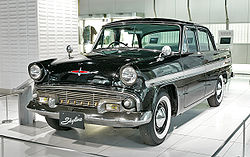 | |
| Overview | |
| Also called | Prince Skyline |
| Production | 1957-1963 33,759 units sold |
| Body and chassis | |
| Body style | 4-door sedan 4-door delivery van 2-door coupe |
| Layout | FR layout |
| Related | Prince Skyway Prince Miler |
| Powertrain | |
| Engine | 1.5 L GA-30 I4 1.5 L GA-4 I4 1.9 L GB-30 I4 |
| Dimensions | |
| Curb weight | ~1300 kg (~2866 lb) |

The first Skyline was introduced in April 1957,[6] under the Prince marque, and was marketed as a luxury car. It featured a 1.5 L (1482 cc) GA-30 engine producing 44 kW (60 hp) @ 4,400 rpm.[7] It used a de Dion tube rear suspension and was capable of 140 km/h (87 mph). The car weighed around 1300 kg. Prince Skylines were produced as four door sedans and five door station wagons.
The Skyline also spawned a pickup truck called the Prince Miler and a delivery van called the Prince Skyway.
ALSI-2
The Skyline was updated with quad headlights for 1958.
This model was powered by a slightly altered 1.5 L engine known as the GA-4 OHV (1484 cc) producing about 70 hp (52 kW) @ 4800 rpm and was produced through 1961.
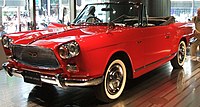
BLRA-3
The Skyline Sport featured hand-built Michelotti bodies in stylish coupe and convertible versions. These cars used the 1.9 L (1862 cc/113 in³) GB-30 engine, producing 96 hp (72 kW) and 113.5 ft·lbf (154 N m). While only a few hundred were built, Prince Motors had a very aggressive product placement group and they can be seen (along the company's mainstream models) in many Toho films of the early 1960s.
S50 or BLSID
| S50/S54/S57 | |
|---|---|
 | |
| Overview | |
| Also called | Prince Skyline |
| Production | 1963-1968 114,238 units sold |
| Body and chassis | |
| Body style | 4-door sedan |
| Layout | FR layout |
| Related | Prince Skyway Prince Miler |
| Powertrain | |
| Engine | 1.5 L G-1 I4 (S50) 2.0 L G-7 I6 (2000GT) 1.5 L G15 I4 (S57) |
| Transmission | 5-speed manual |
In 1961 Fuji Precision Industries changed its name to Prince after the 1954 merger, and the S50 series was launched, which like its predecessor, came in sedan and wagon bodystyles. This was the second generation car, and became one of the more desirable cars in Japan. It was powered by the G-1 engine,[7] a 70 hp (52 kW) version of the old GA-4. A 1862 cc engine was also available, delivering 91 hp (68 kW).
In 1962, this model was restyled as the S21S series.
The S50 was further developed with new styling for 1963, and was sold in some markets with an A150 designation.
In 1966, Nissan and Prince merged and the S50 also appeared with Nissan Skyline badging. This model lasted in production through 1967.
S54

Prince created a racing GT Skyline in May 1964. It was based on the S54 and used the larger 6-cylinder G-7 engine from the Gloria S40, though the car needed an 8" extension to the wheelbase (all forward of the cowl/firewall) to provide space in the engine bay for the lankier in-line six. When it entered the 2nd Japanese Grand prix they hoped to win the GT-II class. Competitive against the Porsche 904, the Skyline managed 2nd through to 6th places.
Largely due to the success of the race vehicle, the Prince 2000GT (also called GT-A, GT-B, S54A and S54B) was released to the Japanese market. There were two versions produced:[7]
The B model featured three Weber 40DCOE-18 carburetors, a limited slip differential, 5-speed manual transmission, and power brakes. Both the B and A used front disc brakes with dual pistons.
S57
The S50 Skyline was updated to become the S57 in 1967. It used a Nissan engine, the OHC 1.5 L (1487 cc) G15. At 88 hp (66 kW), it was the most-powerful engine in the Japanese 1500 cc class.
C10
| C10 | |
|---|---|
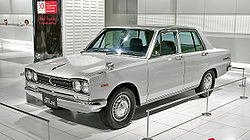 | |
| Overview | |
| Also called | the "Hakosuka" Skyline |
| Production | 1968-1972 310,447 units sold |
| Assembly | Oppama, Japan Tochigi, Tochigi, Japan |
| Body and chassis | |
| Body style | 4-door sedan 5-door station wagon 2-door coupe |
| Layout | FR layout |
| Related | Nissan Laurel |
| Powertrain | |
| Engine | 1.5 L G15 I4 1.8 L G18 I4 2.0 L L20 I6 (2000GT) 2.0 L S20 I6 (GT-R) |
The C10 series of 1968, which began its development under Prince at the company's Opama R&D centre in the suburbs of Tokyo, was marketed with a Nissan badge. By the time the C10 went on sale, the Prince nameplate had been completely phased out on cars and trucks. The dealer network selling the cars became the Prince channel of Nissan, and the marketing group stayed at the Prince headquarters in Mita instead of moving to Nissan's headquarters in Ginza. The C10 Skyline was launched with Nissan's 1.5 L OHC G15 I4 like the S57. A 1.8 L G18 version was also available.
A station wagon variant, known previously as the Prince Skyway, was offered with this generation. A hardtop coupé was introduced in 1970.
2000GT-X

In 1970, the KGC10 2000GT-X received a 2.0 L (1998 cc) L20 I6 engine. The chassis was already designed to receive a straight six, to avoid the S54 extension problem. 120 hp (78 kW) was available from this new engine.
2000GT
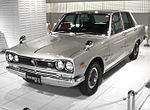
The following year, the GC10 2000GT received a 2.0 L (1998 cc) L20 I6 engine. The chassis was already designed to receive a straight six, to avoid the S54 extension problem. 105 hp (78 kW) was available from this new engine.
GT-R
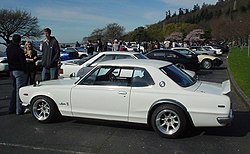
The first GT-R Skyline appeared in February 1969.[8] Called the PGC-10 (KPGC-10 for later coupé version) internally and Hakosuka (ハコスカ) by fans. Hako (ハコ) means Box in Japanese, and suka(スカ) is short for Skyline (スカイライン; Sukairain). It used the 2.0 L (1998 cc) S20 I6. This new DOHC engine produced 160 hp (118 kW, 180 N m), equal to the best sports cars of the time, and was similar to the GR8 engine used in the Nissan R380 racing car.
The GT-R began as a sedan, but a 2-door coupé version was introduced in March 1971. The cars were stripped of unnecessary equipment to be as light as possible for racing, and performed well at the track. The sedan racked up 33 victories in less than two years, and the coupé stretched this to 50 through 1972.[8]
The C10 raced against many cars including the Toyota 1600 GT5, Isuzu Bellett GTR, Mazda Familia (R100) & Capella (RX-2) - even Porsche. In late 1971 the new Mazda RX-3 became the GT-R's main rival. The GT-R managed a few more victories before the RX-3 ended the GT-R's winning streak.
It is claimed that the art of drifting began among Japanese racers when they purposely engaged their hand brakes as a way to oversteer on their GT-Rs.[citation needed] One such driver who is famous for this was Kunimitsu Takahashi.
Models:
- 1500 - 1.5 L G15 I4, 95 hp (71 kW, 128 N m)
- 1800 - 1.8 L G18 I4, 105 hp (78 kW, 150 N m)
- 2000GT - 2.0 L L20E I6, 120 hp (90 kW, 167 N m)
- 2000GT-R - 2.0 L S20 I6, 160 hp (118 kW, 180 N m)
C110
| C110 | |
|---|---|
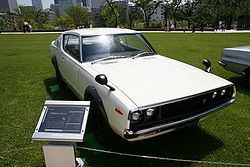 | |
| Overview | |
| Also called | the "Ken and Mary" Skyline |
| Production | 1972-1977 670,562 units sold |
| Assembly | Tochigi, Tochigi, Japan |
| Body and chassis | |
| Body style | 4-door sedan 2-door coupe 5-door station wagon |
| Layout | FR layout |
| Related | Nissan Laurel |
| Powertrain | |
| Engine | 1.6 L G16 I4 1.8 L G18 I4 2.0 L L20B I4 2.0 L S20 I6 2.4 L L24 I6 |


The C110 generation was produced from 1972 through 1977.
For export in the 1970s, the C110 and GC110 Skyline was sold as the Datsun K-series, with models such as the Datsun 160K, 180K and Datsun 240K.
The body styles were, once again, four-door sedan, two-door hardtop coupé, and five-door station wagon. The C110 was more fussy in its styling than its predecessor, particularly so in wagon form, where unusually for a wagon design, no windows were fitted between the C and D pillars. The C110 was the first version to feature the round rear lights, typical of later Skyline designs.
The C110 Skyline was better known as the "Ken & Mary" or "Kenmeri" (ケンメリ) Skyline, stemming from the advertisement campaign in Japan at the time which featured a young couple (Ken and Mary) who relaxed and enjoyed the countryside in Ken and Mary's Skyline (ケンとメリーのスカイライン). The ads were highly successful and perhaps as a result the C110 was sold in very large numbers in Japan. It sold just as well in Australia (in a 2.4L 6-cylinder form, badged as "Datsun 240K") , though few survive today. There, the 240K was about the same price as a Ford Falcon GT or BMW 5 series, around $5000.
GT-R
The Nissan Skyline GT-R hardtop arrived in September 1972 but only lasted until March 1973, when Nissan ceased its production. The oil crisis saw many people preferring economy cars and high-performance sports cars were looked down upon. Nissan pulled out of Motor Racing, so there was no purpose to the GT-R. It was not officially exported anywhere, although Nissan contemplated exporting to Australia. Only 197 KPGC110 GT-Rs were ever sold in Japan,[9] through specialist Nissan Performance shops (before it was called NISMO). This was the last GT-R for 16 years until the BNR32 in 1989.
Models:
- 1600GT - 1.6 L G16 I4
- 1800GT - 1.8 L G18 I4
- 2000GT-X - 2.0 L L20A I6, 130 hp (96 kW, 172 N m)
- 2000GT-R - 2.0 L S20 I6, 160 hp (118 kW, 180 N m)
C210
| C210 | |
|---|---|
  | |
| Overview | |
| Also called | SKYLINE JAPAN I LOVE JAPAN(1979-1981) |
| Production | 1977-1981 539,727 units sold |
| Assembly | Tochigi, Tochigi, Japan |
| Body and chassis | |
| Body style | 4-door sedan 2-door coupe 5-door station wagon |
| Layout | FR layout |
| Related | Nissan Laurel |
| Powertrain | |
| Engine | 1.6 L L16T I4 1.8 L L18T I4 2.0 L L20E I6 2.0 L L20ET I6 |
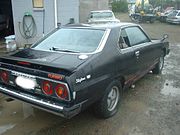
The succeeding C210/211 and GC210/211 of 1977 continued to split the Skyline range into basic and six-cylinder models, the latter with a longer front end. This line continued through 1981. The Datsun C211 240K/280K and 240C/280C variants continued for export.
A rare variant would be the wagon version, which had a unique styling treatment behind the rear doors, of a much smaller window than usual between the C and D pillars.
The GT-EX replaced the GT-R with a turbocharged engine, the L20ET. This was the first turbo engine to power a Japanese production vehicle [citation needed]. One notable aspect of the turbo versions was that they were not intercooled and there was no form of blowoff valve, only an emergency pressure release valve.
The "T" designation on the L16T and L18T does not signify a turbocharger was included; it denotes that those engines came with twin carburetors.
Models:
- 1600TI - 1.6 L L16T I4, 95 hp (71 kW, 132 N m)
- 1800TI - 1.8 L L18T I4, 115 hp (86 kW, 152 N m)
- 2000GT-EL - 2.0 L L20E I6, 130 hp (97 kW, 167 N m)
- 2000GT-EX - 2.0 L L20ET turbo I6, 145 hp (108 kW, 206 N m)
R30
| R30 | |
|---|---|
 | |
| Overview | |
| Also called | New-man SKYLINE(1983-1985) |
| Production | 1981-1985 406,432 units sold |
| Assembly | Tochigi, Tochigi, Japan |
| Body and chassis | |
| Body style | 4-door sedan 2-door coupe 5-door hatchback 5-door station wagon |
| Layout | FR layout |
| Related | Nissan Laurel |
| Powertrain | |
| Engine | 1.8 L Z18S I4 1.8 L CA18E I4 2.0 L Z20E I4 2.8 L LD28 I6 2.0 L L20E I6 2.0 L L20ET I6 2.4 L L24E I6 2.8 L L28E I6 2.0 L FJ20E I4 2.0 L FJ20ET I4 |
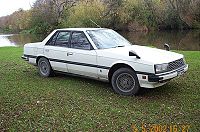
The names were brought into line with the home Japanese and worldwide markets with the launch of the R30 series in August 1981, which was built on a C31 Laurel platform. Unlike preceding generations, four and six-cylinder versions now shared a front end of the same length. The R30 was available as a two door hardtop coupe, a four door sedan, a five door hatchback (available only in the R30 generation) or a four door station wagon. In all, there were 26 variations of the R30 Skyline available.
All versions with the exception of the wagon were usually fitted with the four round tail lights that had become a regular feature to the Skyline's design. The wagon was the ugly duckling of the range, having different tail lights, headlights and no turbo or 6-cylinder versions available - it more closely resembled a Nissan Sunny than a Skyline. The two door coupe had pillarless doors and the unusual feature of roll-down quarter windows for the rear seat passengers (a styling feature of the previous C10, C110 and C211 coupes), while four door versions all had traditional framed windows.
Notably, configurations of the R30 sold in Australia and New Zealand were missing the traditional hotplate tail lights, instead opting for more conventional styling.
Various engine configurations were available, initially ranging from the top of the line 103 kW SOHC 6-cylinder turbo L20ET to the 4-cylinder Z18S and 6-cylinder RD28 diesel versions at the other end of the scale. The all-new 16-valve DOHC FJ20 engine debuted in late 1981, and was the first 4-cylinder engine by any Japanese manufacturer to employ more than two valves per cylinder (see below). Some of the top spec models featured adjustable suspension dampers that could be adjusted while driving, this was another first for mass produced JDM vehicles. Nissan Glorias and Laurels also used the L series engines as well as some diesel (Laurel only) variants.
The R30 range was facelifted in August 1983 with various changes across the board; for example four wheel disc brakes were now standard issue, instead of being optional for lower-spec models. Trim specifications were revised and the 4-cylinder Z18S engine was replaced with the newer CA18E. Upgraded interior trim, new front and rear bumpers, door-mounted wing mirrors (replacing the old 'hockey stick' fender mirrors) and smoked tail lights rounded out the look.
Paul Newman Version
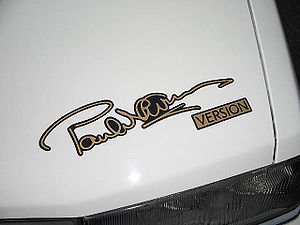
Also that year the Paul Newman Version R30 was released to commemorate the association between Nissan and the actor Paul Newman, who used to appear in promotional material as well as race for the company in the late 1970s - early 1980s. The Newman Skyline was simply a top spec GT-ES turbo with signature embroidery and decals, and is still sought after today amongst collectors in Japan.
RS
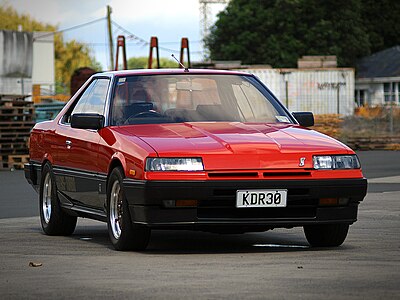
Although making about the same power as the L20ET-powered GT-ES models, the version of the Skyline initially known as the 2000RS was released in October 1981 as more of a stripped-down lightweight racer, without as many luxury extras included (quoted curb weight was only 1,130 kg (2,490 lb)). These were equipped with the naturally aspirated 4-valve per cylinder DOHC FJ20E engine generating 110 kW (150 PS; 148 hp) of power at 6000 rpm and 181 N⋅m (133 lb⋅ft) of torque at 4800 rpm. The official Nissan chassis designation for all FJ20-powered models was DR30.
In February 1983 the DR30 range received a significant boost in performance with the introduction of the turbocharged FJ20ET engine in the 2000RS-Turbo. Front brakes were also significantly upgraded to cope with the power increase. Now with 140 kW (190 PS; 188 hp) of power at 6400 rpm and 225 N⋅m (166 lb⋅ft) of torque at 4800 rpm on tap, the FJ20ET enjoyed new-found prestige as the most powerful Japanese production engine of its era.
Nissan sought to elevate the status of the DR30 Skyline as their new flagship model in light of this success, and it received a generous amount of changes to distinguish it from lesser Skyline models in August 1983. Interior equipment was significantly upgraded to now include electric windows, air conditioning and power steering as standard in the new RS-X model (for Extra) with an increased curb weight of around 1,235 kg (2,723 lb); gone were the days of the spartan, stripped-out race interior, although this could still be specified at time of purchase. But by far the most striking change to the RS was the new unique front end treatment, nicknamed Tekamen (鉄仮面) or Iron Mask by fans for its distinctive look. The headlights were considerably slimmer, and instead of a conventional grille the bonnet now sloped down to two narrow slits above a facelifted front bumper and airdam.[10].
Further changes were made in 1984, most notably the addition of an intercooler, revised compression ratios and turbocharger exhaust housing to the FJ20ET powered model, now known as the RS-Turbo C and increasing output to 151 kW (205 PS; 202 hp) of power at 6400 rpm and 245 N⋅m (181 lb⋅ft) of torque at 4400 rpm. An automatic transmission option was also added at this time, and changes to the "PLASMA Spark" ignition system followed in early 1985 towards the end of R30 production.
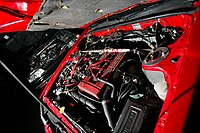
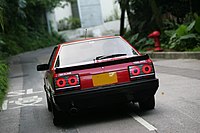
To this day the FJ20-powered R30 Skyline remains a cult car both at home and overseas (there are still dedicated "one make" drag racing events for this model in Japan), and is credited with rejuvenating the Skyline brand in the early 1980s. It also paved the way for the eventual re-introduction of the legendary GT-R badge, markedly absent since the end of C110 Skyline production in 1973.
The RS achieved moderate success in Australian Touring car racing in the mid-1980s with Nissan winning the 1986 Australian Manufacturers' Championship [11] and sharing victory in the 1987 Australian Manufacturers' Championship with BMW.[12]
Models: (Japan)
- 1800TI - 1.8 L Z18S SOHC I4, 105 hp (77 kW), later models 1.8 L CA18S SOHC I4, 105 hp (77 kW)
- 2000TI - 2.0 L CA20E SOHC I4
- 2000TI - 2.0 L Z20E SOHC I4
- 280D GT - 2.8 L LD28 SOHC I6 Diesel
- 2000GT and Passage - 2.0 L L20E SOHC I6
- 2000GT Turbo, Passage and Paul Newman Version - 2.0 L L20ET turbo I6, 140 hp (103 kW, 206 N m)
- RS - 2.0 L FJ20E DOHC I4, 150 hp (112 kW, 181 N m)
- RS-X and RS-X Turbo C - 2.0 L FJ20ET DOHC turbo I4, 190 to 205 hp (140 to 151 kW, 225 to 245 N m)
R31
| R31 | |
|---|---|
 | |
| Overview | |
| Also called | 7th SKYLINE(1985-1987) |
| Production | 1985-1989 309,716 units sold |
| Assembly | Tochigi, Tochigi, Japan |
| Body and chassis | |
| Body style | 4-door sedan 4-door hardtop 2-door coupe 4-door station wagon |
| Layout | FR layout |
| Related | Nissan Laurel Nissan Leopard F31 Nissan Pintara |
| Powertrain | |
| Engine | 1.8 L CA18I I4 2.0 L CA20E I4 2.0 L RB20E I6 2.0 L RB20ET I6 2.0 L RB20DE I6 2.0 L RB20DET I6 2.0 L RB20DET-R I6 3.0 L RB30E I6 2.8 L Diesel RD28 I6 |
The R31 Skyline of 1986 was a natural evolution on the R30 shape, and also this one was loosely based on the Laurel platform (C32). The design was slightly larger and squarer than previous Skylines. It was available as a Sedan, Hardtop sedan, Coupe and station wagon. Affectionately known as the "Seventhsu" or simply "7th Sukairain" by owners, due to it being the 7th generation Skyline.



The R31 Skyline introduced many new technologies and features. The HR31 was the first Skyline to be equipped with the new RB-series of engines. The R31 RB engines are often referred to as "Red Top" engines because of the red cam covers. There were three variants. The earliest series of DOHC RB engines used the NICS (Nissan Induction Control System) injection system with 12 very small intake runners, and a butterfly system to divide the intake ports in half for better low RPM performance. Later versions used ECCS (Electronically Concentrated Control System) engine management, discarded the twelve tiny runners for six much larger ones (though they retained twelve ports on the head, so there was a splitter plate), and received a slightly larger turbocharger. Nissan's RD28, a 2.8 straight-6 engine, featured for a diesel option. Another technological first for the R31 was the introduction of Nissan's proprietary 4-wheel steering system, dubbed HICAS (High Capacity Active Steering). The R31 series were also the only models in the Skyline family to feature a 4-door hardtop variation. These models were generally badged as the Passage GT.
The R31 Skyline was also produced in Australia, with a 3.0 L motor (RB30E) available in sedan or wagon form, as well as a four-cylinder version called the Nissan Pintara. The wagon had the same front style as the coupe and sedan—the only difference being that it lacked the four round brake lights that had been a consistent element of Skyline design (except for the R31 series one/two which had rectangular taillights with a solid bar through the centre which was also shared by the Pintara). These cars were manufactured in Australia due to the heavy import laws which made it expensive to bring cars into Australia.
29,305 R31 Skylines were also manufactured and sold in South Africa in 4-door sedan form between 1987 and 1992. These were the last Skylines seen in South Africa. Power came from either the RB30E 3.0 straight-6 motor, RB20E 2.0 straight-6 motor or the CA20S 4-cylinder powerplant.
GTS-R
The ultimate version of the R31 was the RB20DET-R powered HR31 GTS-R Coupe of which 800 units were built to allow homologation for Group A Touring Car racing. It had a reworked version of the normal RB20DET with a much larger turbocharger on a tubular steel exhaust manifold, as well as a much larger front mounted intercooler boosting power to a factory claimed 210 ps (154 kW), with racing versions making over 430 hp (321 kW) in Group A trim.
Models
'Japan'
- 1800 C, 1800 EXCEL and 1800 PASSAGE - 1.8 L CA18S SOHC I4, 90 hp (66 kW)
- GT EXCEL D, GT PASSAGE D - 2.8 L Diesel RD28 SOHC I6, 92 hp (68 kW, 173 N m)
- GT EXCEL, GT PASSAGE - 2.0 L RB20E SOHC I6, 128 hp (96 kW)
- GT EXCEL TWIN CAM 24V, GT PASSAGE TWIN CAM 24V - 2.0 L RB20DE DOHC I6, 155 hp (114 kW)
- GT PASSAGE TURBO - 2.0 L RB20ET SOHC turbo I6, 167 hp (125 kW, 206 N m)
- GT PASSAGE TWIN CAM 24V TURBO - 2.0 L RB20DET DOHC turbo I6, 180 hp (133 kW, 225 N m)
- GTS - 2.0 L RB20DE DOHC I6, 155 hp (114 kW)
- GTS Turbo - 2.0 L RB20DET DOHC I6, 180 hp (133 kW, 225 N m)
- GTS-X - 2.0 L RB20DET DOHC turbo I6, 190 hp (141 kW, 240 N m)
- GTS-R - 2.0 L RB20DET-R DOHC turbo I6, 210 hp (154 kW, 245 N m)
- GTS Autech - 2.0 L RB20DET-R DOHC turbo I6, 210 hp (154 kW, 245 N m)
'Australia'
- Pintara - 2.0 L CA20E I4, 102 hp (78 kW, 160 N m)
- GX, Executive, GXE, Silhouette, Ti - 3.0 L RB30E SOHC I6, 155 hp (114 kW, 247 N m)
- GTS1 - 3.0 L RB30E SOHC I6, 176 hp (130 kW, 255 N m)
- GTS2 - 3.0 L RB30E SOHC I6, 190 hp (140 kW, 270 N m)
'South Africa'
- 2.0GL, 2.0GLE - 2.0 L CA20S I4, 106 hp (78 kW, 163 N m)
- 2.0SGLi - 2.0 L RB20E SOHC I6, 115 hp (85 kW, 174 N m)
- 3.0SGLi - 3.0 L RB30E SOHC I6, 171 hp (126 kW, 260 N m)
R32
| R32 | |
|---|---|
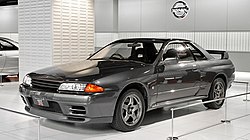 | |
| Overview | |
| Also called | SKYLINE(1989-1991) |
| Production | 1989-1994 296,087 units sold GT-R's Standard-40390 Nismo-560 vspec-1453 vspecII-1303 N1-228 |
| Assembly | Tochigi, Tochigi, Japan |
| Body and chassis | |
| Body style | 4-door sedan 2-door coupe |
| Layout | Front engine, rear-wheel drive / all-wheel drive |
| Related | Nissan Laurel Nissan Cefiro |
| Powertrain | |
| Engine | 1.8 CA18I I4 2.0 L RB20E I6 2.0 L RB20DE I6 2.5 L RB25DE I6 2.0 L RB20DET I6 2.6 L RB26DETT I6 (GT-R, GTS-4R) |
| Transmission | 5-speed automatic 5-speed manual |
| Dimensions | |
| Wheelbase | 2615mm |
| Length | 4545mm |
| Width | 1755mm |
| Height | 1340mm |
| Curb weight | 1280 kg (type-m) 1430 kg (GT-R, GTS-4R) |


The HCR32 Skyline debuted in May 1989. It was available as either a 2-door coupe or 4-door hardtop sedan, all other bodystyles were dropped. The R32 featured several versions of the RB-series straight-6 engines, which had improved heads (the twelve port inlet was gone) and used the ECCS (Electronically Concentrated Control System) injection system. Also available were an 1,800 cc 4 cylinder GXi model. Most models had HICAS four-wheel steering, with the rear wheels being hydraulically linked to the front steering. The 2.5 litre version became one of the first cars made in Japan to feature a 5-speed automatic transmission. The GTS-t Type M included larger five-stud 16 inch wheels, four piston front callipers and twin piston rears. ABS was optional (except for the GT-R), viscous LSD was standard on all turbo models and optional on all but the GXi. Nissan also produced 100 Australian models of the R32. These were the only non-Japan only Skylines ever produced. There was also a 4WD version of the GTS-t Type M, called the GTS-4.
R32 Models:
- GXi Type-X - 1.8 L CA18i I4, 91 hp (67 kW)
- GTE Type-X - 2.0 L RB20E I6, 125 hp (93 kW, 152 N m)
- GTS Type-X, S, J - 2.0 L RB20DE I6 155 hp (115 kW, 154 N m)
- GTS-25 Type-X, S, XG - 2.5 L RB25DE I6, 180 hp (134 kW, 231 N m)
- GTS-t Type-M - 2.0 L RB20DET turbo I6, 212 hp (158 kW, 263 N m)
- GTS-4 - 2.0 L RB20DET turbo I6, 212 hp (158 kW, 263 N m)
- Autech Skyline - 2.6 L RB26DE I6, 217 hp (162 kW, Autech Version - auto only)
- GT-R - 2.6 L RB26DETT twin-turbo I6, 276 hp (280ps) (206 kW, 368 N m) also NISMO,N1, V-Spec, and V-Spec II variants.
- NISMO S-Tune
GT-R
The returned with twin ceramic turbochargers, all-wheel steering, electronically controlled all wheel drive, and 276 hp (206 kW) at 6800 rpm.[13] The RB26DETT engine actually produced ≈320 hp, but it was unstated due to the Japanese car makers' "gentlemen's agreement" not to exceed 280 PS (206 kW). The engine was designed for 1500 hp in street cloth,[14] and then muzzled by the spark plugs, de-turboed, and race spec ECU. The electronic non-turbo boost control had a small physical significance to that of an actual sprint car. It was marked in yellow so the new owner could remove it and enjoy a safe factory boost and slide driving abilities.[15] After this increase the car would put out ≈230 KWATW and could do 0–100 km/h in 4.7 seconds and a quarter mile in 9.8 seconds.[citation needed]
The GT-R had a significantly larger intercooler, larger brakes, and aluminium front guards and bonnet. Other distinguishing features include flared front and rear wheel arches. More supportive seats were fitted, and the turbo boost gauge and digital clock were removed from inside the instrument cluster. The clock was replaced with a torque meter that indicated how much torque was being delivered to the front wheels (0%–50%). Oil temp, voltage, and turbo boost gauges were fitted just above the climate control.
The Porsche 959 was Nissan's target when designing the GT-R. The chief engineer, Naganori Itoh, intended to use the car for Group A racing, so the design specification was drawn up in conjunction with a copy of the Group A rules. The Nordschleife production car record at the time of development was 8'45" - set by a Porsche 944. Nissan test driver Hiroyoshi Katoh reset the record with a time of 8'20".[16] Best Motoring managed 8'22"38.[17]
The R32 GT-R dominated Japanese Touring Car Championship (JTCC), winning 29 races from 29 starts, taking the series title every year from 1989 to 1993.[18] It took 50 races from 50 starts from 1991 to 1997 (latterly R33) in the N1 Super Taikyu.
The R32 GT-R was introduced in to the Australian Touring Car Championship in 1990 and promptly ended the reign of the previously all-conquering Ford Sierra Cosworth, winning Bathurst 1000 classic in 1991 and 1992. This success led to the Australian motoring press nicknaming the car Godzilla due to it being a "monster from Japan". As Australia was the first export market for the car the name quickly spread. Such was GT-R's dominance that it is seen by some[who?] as a significant factor in the demise of Group A Touring Car racing, the formula being scrapped soon after. JTCC was similarly blighted by the R32 GT-R, and splintered soon after, leading to the switch to the Supertouring category and also indirectly to the GT500 category of today.
When originally designed, the homologation rulebook mandated 16-inch wheels, so that's what the GT-R got. This limited the size of the brakes, and the Nissan four pots weren't really up to competition use. A later change in rules allowed 17-inch wheels, so in February 1993 the GT-R V-spec (for Victory) emerged wearing 17" BBS mesh wheels(225/50/17) covering larger Brembo brakes. The clutch actuation changed from a push to a pull system, the car had the standard rear differential, the electronic rear differential did not show up until the R33 Vspec. A year later the V-Spec II appeared with a new sticker and wider tires(245/45/17).[19]
R33
| R33 | |
|---|---|
 | |
| Overview | |
| Production | 1993-1998 217,133 units sold |
| Assembly | Tochigi, Tochigi, Japan |
| Body and chassis | |
| Body style | 4-door sedan 2-door coupe |
| Layout | Front engine, rear-wheel drive / all-wheel drive |
| Related | Nissan Laurel Nissan Stagea |
| Powertrain | |
| Engine | 2.0 L RB20E I6 2.5 L RB25DE I6 2.5 L RB25DET I6 2.6 L RB26DETT I6 (GT-R) 2.8 L RBX-GT2 I6 (400R) |
| Transmission | 4-speed automatic 5-speed manual 5-speed automatic |
| Dimensions | |
| Curb weight | 1390 kg (GTS25-T) 1530 kg (GT-R) |
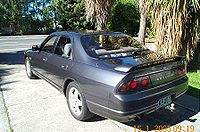
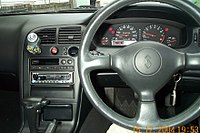
The R33 Skyline was introduced in August 1993. Slightly heavier than the R32, it is available in coupe and sedan bodystyles. All models now used a 6-cylinder engine. Nissan took the unusual step of down-grading the GTS model to have only the RB20E, while the twin-cam of the R32 GTS was discontinued along with the 2.0 L turbo RB20DET.
Some models came equipped with a new version of the HICAS 4-wheel steering system called Super HICAS. This computer controlled system was first used on the R32 GTR. Super HICAS used electric actuators to steer the rear, as opposed to the hydraulic HICAS.
As an option, an active limited slip differential was available instead of the standard viscous LSD. This new unit locked the rear differential if it detected that traction was lost by one of the wheels. A light on the dash also lit up if the LSD engaged. Active LSD came standard on all V-spec R33 GT-R Skylines and was also available on some ECR33 GTS25t models; these can be identified by the A-LSD and SLIP lights on the tachometer.
The RB25DE and RB25DET engines also became equipped with NVCS (variable inlet cam phasing). NVCS equipped RBs have a bulge on the front of the cam cover. To celebrate their 40th anniversary, Nissan introduced a very rare 4 door GT-R. Two versions of the 4-door GT-R were available from Nissan's subsidiaries: the first was produced by Autech, and the second was a joint Autech/Nismo project.
An R33 based wagon was released in September 1996, called the Stagea. It had a different body style than the R33 and R34 and (with the exception of the RS FOUR & Autech variants) was only available with an automatic transmission. A common modification on the Stagea is to fit it with an R34 skyline front, in effect making a 4 door R34 wagon. The Stagea is the only all wheel drive manual transmission Nissan on the R33 platform with the RB25DET engine. Presumably, a 5 speed AWD Skyline equipped with an RB25DET would have been too close in performance to the much more expensive GT-R. There was also an Autech Stagea, the 260RS released with full GT-R running gear, the RB26DETT engine, body kit, 17" BBS style alloys, GT-R instrumentation, and manual transmission.[20]
R33 models:
- HR33 GTS - 2.0 L RB20E SOHC I6, 130 PS (96 kW, 172 N m)
- ER33 GTS25 - 2.5 L RB25DE DOHC I6, 190 PS (140 kW, 231 N m)
- ENR33 GTS-4 - 2.5 L RB25DE DOHC I6, 190 PS (140 kW, 231 N m) AWD
- ECR33 GTS25T - 2.5 L RB25DET DOHC turbo I6, 250 PS (184 kW, 294 N m)
1996
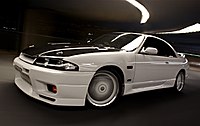
The R33 Skyline (Series 2) continued the concepts introduced in the R32. Driver and Passenger airbags became standard in 1996. As a result, pre-1996 models are barred from being imported into various countries for consumer road use as they do not meet the frontal impact standards[citation needed]. For the RB25DET engine the ignition system was also changed, with the ignition module no longer located on the cam covers and was instead replaced by smart ignition coils (Ignitor built into coil) and ECU. The RB25DET turbo was also given a nylon compressor wheel. Throughout the time the R33 was produced there were quite a number of different styled lights and bodykits fitted, the actual body/chassis underwent no changes. Among the cosmetic changes in the series 2 were, the headlights which tapered down more towards the grill and were fitted with improved reflectors, the grill (which was longer on the Series 1), the bonnet which had a re-shaped leading edge to fit the new lights and front bumper changing shape in the smallest amount to match the lower edge of the new headlights. Later models of the Series 2 also had the option of having an Active-LSD fitted. The R33 ceased production in March 1998 with the 40th Anniversary R33 Series 2...
GT-R
The BCNR33 GT-R version also had the same RB26DETT engine that the BNR32 was equipped with, although torque had been improved, due to changes in the turbo compressor aerodynamics, turbo dump pipe, and intercooler. The turbo core changed from a sleeve bearing to a ball bearing, but the turbine itself remained ceramic, except on N1 turbos (steel turbine, sleeve bearing). From the R33 onward, all GT-Rs received Brembo brakes.[21] In 1995 the GT-R received an improved version of the RB26DETT, the ATTESA-ETS all wheel drive system, and Super HICAS all-wheel steering.
A limited edition model was created in 1996, called the NISMO 400R, that produced 400 hp (298 kW) from a road-tuned version of Nissan's Le Mans engine.[22] A stronger six speed Getrag gearbox was used.
An R33 GT-R driven by Dirk Schoysman lapped the Nordschleife in less than 8 minutes. Though it was often said to be the first production car to break 8 minutes, the limited run Jaguar XJ220 had already achieved a 7'46" lap.[23] Other manufacturers had caught up since the R32 was released, and the R33 never dominated motorsport to the extent of the R32.
Michael Begley with the Gaijin R33 GTR [2] currently holds the European four wheel drive 1/4 mile record with a time of 8.06 @ 173 mph. This record was set at Santa Pod raceway in England. Gaijin ("the outsider") is tuned by TR Racing in Harlow Essex UK. This R33 GTR is said to have had in the region of 1400 bhp. The owner Mick Begley lives in the UK and is reportedly chasing a 7 second pass.
- GT-R - 2.6 L RB26DETT DOHC twin-turbo I6, 305 PS (224 kW, 375 N m) (advertised as 280 PS) AWD
- GT-R LM - 2.6 L RB26DETT DOHC twin-turbo I6, 305 PS (224 kW) FR
- NISMO 400R - 2.8 L RBX-GT2 DOHC twin-turbo I6, 400 PS (294 kW, 478 N m) AWD
- 4Dr.GT-R Autech.version - 2.6 L RB26DETT DOHC twin-turbo I6, 305 PS (224 kW, 375 N m) (advertised as 280 PS) AWD
R34
| R34 | |
|---|---|
 | |
| Overview | |
| Production | 1998–2002 64,623 units sold |
| Assembly | Tochigi, Tochigi, Japan |
| Body and chassis | |
| Body style | 4-door sedan 2-door coupe |
| Layout | Front engine, rear-wheel drive / all-wheel drive |
| Related | Nissan Laurel Nissan Stagea |
| Powertrain | |
| Engine | 2.0 L RB20DE I6 2.5 L RB25DE I6 2.5 L RB25DET I6 2.6 L RB26DETT I6 |
| Transmission | 4-speed automatic 5-speed manual 6-speed manual |
| Dimensions | |
| Curb weight | 1540 kg (GT-R) 1410 kg (GT-T) |

In May 1998, the HR/ER/BNR34 addressed many of the concerns over the change from the R32 to the R33, with more emphasis on sportiness, and marked the introduction of the more fuel-efficient and environmentally-friendly RB25DET NEO engine. The RB20E engine was discontinued in the R34 base model (GT), and the RB20DE, after last being used in the R32 Skyline, was reintroduced in updated NEO guise. The R34 GT powered by the RB20DE NEO, coupled with a 5-speed gearbox, became the most fuel-efficient straight-6 Skyline to date (of any shape). It was not the most fuel-efficient straight-6 of its time though; the 1998 Toyota Supra had better reported fuel economy. The 5-speed automatic transmission available on some models in the previous two shapes were discontinued. In its place, Nissan produced a 4-speed Tiptronic transmission for all of the automatic versions (Except the base 2.0L, which has a standard 5 speed gearbox).
Models:
- GT - 2.0/2.5 L RB20DE NEO I6, 155 ps (114 kW)
- 25 GT, GT-X, GT-V - 2.5 L RB25DE NEO I6, 200 ps (147 kW)
- GT-FOUR - 2.5 L RB25DE NEO I6, 200 ps (147 kW) AWD
- GT-T - 2.5 L RB25DET NEO turbo I6, 280 hp (206 kW, 343 N m)
GT-R
The GT-R reappeared in 1999, with a revised chassis and other updates. The R34 turbos received a ball bearing core. The R34 N1 turbos had a metal exhaust wheel, and ball bearing center section. A 6-speed Getrag gearbox was used. The turbo outlet pipes were changed from cast to formed metal outlets. The intercooler had a temperature probe in the V-spec models.
Models:GT-R' - 2.6 L RB26DETT twin-turbo I6, 332 PS (244 kW, 392 Nm) (advertised as 280)[24]
- GT-R V-Spec - Additional aero parts, brake ventilation ducts, diffuser.
- GT-R V-Spec II - As above + carbon fibre hood with NACA duct.
- GT-R N1 - Blueprinted N1 motor, no A/C, no stereo, no rear wiper, basic interior trim. (only 45 made)
- GT-R M-Spec - Leather interior, softer suspension with "Ripple Control" dampers, heated seats.
- GT-R V-Spec II Nür - As above V-Spec II + N1 motor, 300 km/h speedo. (only 750 made)
- GT-R M-Spec Nür - As above M-Spec + N1 motor, 300 km/h speedo. (only 250 made)
- GT-R NISMO R-tune
- GT-R NISMO Z-tune - 2.8 L (bored and stroked) RB26DETT Z2 twin-turbo I6, 500 PS (368 kW, 540 Nm) Z1 and Z2 (Only 20 made)
Marketing
As part of Nissan Skyline's 50th anniversary, Warner Music Japan published a CD titled SKYLINE 50th ANNIVERSARY CD, featuring music from Nissan Skyline commercials.[25][26] Skyline model cars had also been produced.[27] Nissan also staged an exhibition in midtown Tokyo called Grand Touring - The Legend and the Future in which examples of all twelve generations of Skyline were shown.[28]
V35
| V35 | |
|---|---|
 | |
| Overview | |
| Also called | Infiniti G35 |
| Production | sedan: 2001-2006 coupe: 2001-2007 |
| Assembly | Tochigi, Tochigi, Japan |
| Body and chassis | |
| Body style | 4-door sedan 2-door coupe |
| Layout | Front engine, rear-wheel drive / All wheel drive |
| Platform | Nissan FM platform |
| Powertrain | |
| Engine | 2.5 L VQ25DD V6 3.0 L VQ30DD V6 3.5 L VQ35DE V6 |
| Transmission | 5-speed automatic 6-speed manual CVT Continuously Variable Transmission |
| Dimensions | |
| Wheelbase | 2850 mm (112.2 in) |
| Length | 4630 mm (182.2 in)(coupe) 4735 mm (186.5 in) (sedan) |
| Width | 1815 mm (71.5 in) (coupe) 1750 mm (69 in) (sedan) |
| Height | 1390 mm (54.8 in) (coupe) 1465 mm (57.7 in) (sedan) |
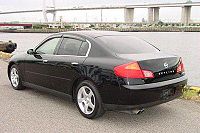
The 11th generation (V35) Nissan Skyline, introduced in June 2001, was based on Nissan's FM platform, shared with the Nissan 350Z. The Nissan Skyline used a front-midship engine (VQ35DE), rear-wheel drive layout[29] (all-wheel drive was available for the sedan) to achieve a 52%/48% weight distribution. The V35 was the first Skyline made for export to the United States. There it was sold under the company's luxury brand, Infiniti as the Infiniti G35.

The V35 was a major turning point for the Skyline. There was no straight 6, no turbo, and no GT-R, a decision which extended to all later Skylines. However, despite the departure in these trademark characteristics, Nissan's decision to include a bigger engine and improve balance made many media outlets name the V35 as "the best Skyline ever", and it has continued to revive the Skyline brand internationally [29]. Choosing to gear the V35 towards the luxury-sport market, and billing the 350z as a pure sports car, Nissan put a slightly more powerful VQ35DE in the 350Z, and while the Skyline and the 350Z shared the same platform, the 350Z had additional bracing, underbody aero parts, and weighed 100 kg less.[5]
A Japan-only Skyline with an 8-speed CVT (Continuously Variable) transmission was also sold. It was a sedan model called the 350GT-8. The 8 was for the 8-speed transmission.
Japanese tuners mostly ignored the V35 Skyline, the 2006 Tsukuba Super Lap Battle had not a single V35 entrant.[1] Tuners such as Mines, Amuse, Hosaka, Garage Defend, M Speed, Nagisa, MCR, HKS, & Top Secret continued developing R32-R34 GT-Rs as time attack cars. Top Secret did tune a V35, but replaced the VQ35DE with a VK45DE V8 Twin Turbo.[30] Signal USA entered a V35 in Formula D, replacing the VQ35DE with an SR20DET.[31]
Models:
- 250GT - 2.5 L VQ25DD V6, 215 PS (158 kW, 270 N m)
- 250GT Four - 2.5 L VQ25DD V6, 215 PS (158 kW, 270 Nm) AWD
- 300GT - 3.0 L VQ30DD V6, 260 PS (191 kW, 324 N m)
- 350GT-8 - 3.5 L VQ35DE V6, 272 PS (200 kW, 353 N m)
- 350GT Coupe - 3.5 L VQ35DE V6, 280 PS (206 kW, 363 N m)
V36/J50
| V36, J50 | |
|---|---|
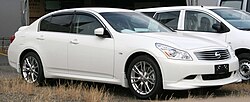 | |
| Overview | |
| Also called | Infiniti G35 Infiniti G37 Infiniti EX37 |
| Production | 2006- |
| Assembly | Tochigi, Tochigi, Japan |
| Body and chassis | |
| Body style | 4-door sedan 2-door coupe 2-door convertible 5-door SUV |
| Layout | Front engine, rear-wheel drive / all-wheel drive |
| Platform | Nissan FM platform |
| Related | Infiniti FX Infiniti M Nissan 350Z Infiniti G37 Infiniti EX |
| Powertrain | |
| Engine | 2.5L VQ25HR V6 3.7L VQ37VHR V6 |
| Transmission | 5-speed automatic 6-speed manual 7-speed automatic |
| Dimensions | |
| Wheelbase | 2850 mm (112.2 in) |
| Length | 4750 mm (187.0 in) (sedan) |
| Width | 1775 mm (69.8 in) (sedan) |
| Height | 1455 mm (57.2 in) (sedan) 1470 mm (57.8 in)(xAWD sedan) |
The 12th generation Skyline appeared on 20 November 2006.[32]
It was first available only as a 4-door sedan in Japan and was also sold in the USA as the 2007 Infiniti G35. It is equipped with either a VQ25HR 2.5 L V6 producing 165 kW or a VQ35HR 3.5 L V6 with 232 kW. The 2.5 L is available with all-wheel drive as well.
On May 13, 2008, Nissan announced that a convertible variant of the Infiniti G37 (U.S. Spec Skyline coupe) will be produced for the 2009 model year.
250GT sedan (DBA-V36, DBA-NV36)
All wheel drive is standard on 250GT FOUR models.
250GT Type S was introduced for 2008 model year.
17-inch wheels are standard for all model ranges, except for the 250GT Type S, which has 18-inch wheels.
350GT sedan
It is a Japanese version of the G35 sedan.
4-wheel active steering is available in Type S and Type SP as option.
370GT coupe (DBA-CKV36)
Introduced in 2007 for the 2008 model year, it is a Japanese version of the Infiniti G37 coupe.
18-inch wheels are used on the base and 370GT Type P cars, while Type S and Type SP cars include 19-inch wheels.
370GT sedan (DBA-KV36)
Introduced in 2008 for the 2009 model year, it is a Japanese version of the Infiniti G37 sedan. It replaced the 350GT sedan.
18-inch wheels are standard for all model ranges, except for the 370GT Type P, which has 17-inch wheels.
50th Limited (2008-)
It is an option for 250GT Type P, 350GT Type P, 350GT Type SP, 250GT FOUR Type P, commemorating 50th anniversary of Nissan Skyline.[33] The interior is marked with anniversary red leather seats, and serial numbered front glass. This package went on sale on 2008-03-31.[34]
370GT crossover (DBA-J50, DBA-NJ50)
Introduced in 2009, it is based on Infiniti EX37. The vehicle went on sale in 2009-04-18.[35]
All wheel drive is standard on 370GT FOUR models.
18-inch wheels are standard for all model ranges.
Body styles
| Chassis code | V36 | J50 |
|---|---|---|
| Body style | coupe, sedan | crossover |
Models
| Model | Years | Engine Type/code | Power, torque@rpm | Drive |
|---|---|---|---|---|
| 250GT sedan (DBA-V36) | 2006- | 2,495 cc (2.495 L; 152.3 cu in) V6 (VQ25HR) | 225 PS (165 kW; 222 hp)@6800, 263 N⋅m (194 lb⋅ft)@4800 | RWD |
| 250GT FOUR sedan (DBA-NV36) | 2006- | 2,495 cc (2.495 L; 152.3 cu in) V6 (VQ25HR) | 225 PS (165 kW; 222 hp)@6800, 263 N⋅m (194 lb⋅ft)@4800 | AWD |
| 350GT sedan | 2006–2008 | 3,498 cc (3.498 L; 213.5 cu in) V6 (VQ35HR) | 315 PS (232 kW; 311 hp)@6800, 358 N⋅m (264 lb⋅ft)@4800 | RWD |
| 370GT coupe (DBA-CKV36) | 2007- | 3,696 cc (3.696 L; 225.5 cu in) V6 (VQ37VHR) | 333 PS (245 kW; 328 hp)@7000, 363 N⋅m (268 lb⋅ft)@5200 | RWD |
| 370GT sedan (DBA-KV36) | 2008- | 3,696 cc (3.696 L; 225.5 cu in) V6 (VQ37VHR) | 330 PS (240 kW; 330 hp)@7000, 361 N⋅m (266 lb⋅ft)@5200 | RWD |
| 370GT crossover (DBA-J50) | 2009- | 3,696 cc (3.696 L; 225.5 cu in) V6 (VQ37VHR) | 330 PS (240 kW; 330 hp)@7000, 361 N⋅m (266 lb⋅ft)@5200 | RWD |
| 370GT FOUR crossover (DBA-NJ50) | 2009- | 3,696 cc (3.696 L; 225.5 cu in) V6 (VQ37VHR) | 330 PS (240 kW; 330 hp)@7000, 361 N⋅m (266 lb⋅ft)@5200 | AWD |
Transmissions
| Model | Years | Standard | Optional |
|---|---|---|---|
| 250GT sedan | 2006- | 5-speed automatic | - |
| 350GT sedan | 2006–2008 | 5-speed automatic | - |
| 370GT coupe | 2007–2008 | 5-speed automatic | 6-speed manual (Type S, Type SP) |
| 370GT coupe | 2008- | 7-speed automatic | 6-speed manual (Type S, Type SP) |
| 370GT sedan | 2008- | 7-speed automatic | - |
| 370GT crossover | 2009- | 7-speed automatic | - |
GT-R
| Nissan GT-R[36] | |
|---|---|
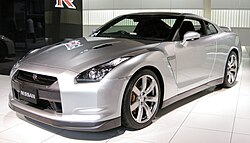 | |
| Overview | |
| Manufacturer | Nissan |
| Production | Q4 2007–present |
| Assembly | Tochigi, Tochigi, Japan |
| Designer | Shirō Nakamura |
| Body and chassis | |
| Class | Sports car |
| Body style | 2-door coupé |
| Layout | Front engine, all-wheel drive |
| Platform | Premium Midship |
| Powertrain | |
| Engine | 3.8L VR38DETT twin-turbo V6 |
| Transmission | 6-speed semi-automatic dual clutch transmission[37] |
| Dimensions | |
| Wheelbase | 2,780 mm (109.4 in) |
| Length | 4,655 mm (183.3 in) |
| Width | 1,895 mm (74.6 in) |
| Height | 1,370 mm (53.9 in) |
| Curb weight | 1,740 kg (3,840 lb) |
| Chronology | |
| Predecessor | Nissan Skyline GT-R R34 |
The Nissan GT-R is a supercar produced exclusively by Nissan, released in Japan on December 6, 2007, the United States on July 4, 2008, and the rest of the world in March 2009.[38][39][40]
History
Nissan Skyline GT-R
Between 1969 and 1974, and again between 1989 and 2002, Nissan produced a high performance version of its Skyline range called the Nissan Skyline GT-R. This car proved to be iconic for Nissan[41][42] and achieved much fame and success on road and track. The Nissan GT-R, although no longer carrying the "Skyline" badge, has heritage in the Nissan Skyline GT-R. Like the Skyline GT-Rs R32 through R34, the Nissan GT-R is all-wheel drive with a twin-turbo 6 cylinder engine; however, the evolutionary, incremental changes between Skyline models R32 through R34 have been done away with. The four-wheel-steering HICAS system has been removed, and the former straight-6 RB26DETT engine has been replaced with a new V6 VR38DETT.[43] Because of the GT-R's heritage, the chassis code for the all-new version has been called CBA-R35,[44] or 'R35' for short, carrying on the naming trend from previous Skyline GT-R generations. The GT-R has also retained its Skyline predecessor's nickname Godzilla.[45][46]
Concepts

Two concept vehicles were displayed at motor shows prior to the unveiling of the production model. The first concept was shown at the Tokyo Motor Show in 2001 to preview what a 21st century GT-R would look like.[47] At the 2005 Tokyo Motor Show, Nissan unveiled a redesigned concept, the GT-R Proto, stating that the production GT-R would be 80-90% based on this concept.[48]
Production
Production model
The production version of the GT-R debuted at the 2007 Tokyo Motor Show, launching in the Japanese market on December 6, 2007. The U.S. official launch was 7 months later on July 7, 2008. Universal Nissan in Los Angeles provided a customer with the delivery of a new GT-R, fresh from the production line at 12:01 a.m., on July 7, 2008. The Canadian launch was also in July 2008. Europe became the third consumer market, where it launched in March 2009. The large disparity in initial marketing between these regional releases is due to Nissan having to build GT-R performance centers where the car is serviced. Also the engine and rear-mounted dual-clutch gearbox are built by hand, thus limiting production to around 1000 cars a month.[49]
Specifications
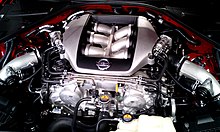
The Nissan GT-R is powered by the VR38DETT engine, a 3,799 cc (3.8 L; 231.8 cu in) DOHC V6. Two parallel Ishikawajima-Harima Heavy Industries (IHI) turbochargers provide forced induction.[50] Production vehicles produce a manufacturer-claimed engine output of 474 bhp (353 kW) at 6400 rpm and 434 lb⋅ft (588 N⋅m) at 3200-5200 rpm.[51] According to independent dynamometer tests, the GT-R produces 416 hp (310 kW) to 475 hp (354 kW) and 414 lb⋅ft (561 N⋅m) to 457 lb⋅ft (620 N⋅m) at the wheels.[52][53] The engine also meets California Air Resources Board Ultra Low Emission Vehicle (ULEV) standards.[54] A curb weight of 1,730 kg (3,810 lb) or 1,736 kg (3,827 lb) with side curtain airbags is achieved using a jig welded steel chassis with aluminum used for the hood, trunk, and doors.[55] A rear mounted six-speed BorgWarner dual clutch semi-automatic transmission is used in conjunction with the ATTESA E-TS system to provide power to all four wheels and along with Nissan's Vehicle Dynamics Control (VDC-R) aids in stability. Three shift modes can also be selected for various conditions. The GT-R has a drag coefficient of 0.27.[56]
- Displacement: V6 3,799 cc (3.8 L; 231.8 cu in)
- Horsepower: 480 bhp (360 kW) at 6400 rpm* 485 bhp (362 kW)**
- Torque: 430 lb⋅ft (580 N⋅m)* 434 lb⋅ft (588 N⋅m)**
- Twin Turbo maximum boost: 17.8 psi (123 kPa)*
- Redline: 7000 rpm
- Drivetrain: Premium Midship AWD
- Curb weight: estimated 3,800 lb (1,700 kg)*
- Production: 2500 units per year (US)
- Price: US$76,840 to US$80,090[57]
- Top Speed: 193 mph (311 km/h)*
- * manufacturer claimed
- ** 2010 model year
Performance

Nissan claims the GT-R can reach a top speed of 311 km/h (193 mph),[58] Motor Trend recorded a top speed of 195.0 mph (313.8 km/h).[59] It has been tested to achieve 0-60 mph (97 km/h) times as low as 3.2 seconds with "launch control"[60] and 3.8 seconds without[61] (improved to 3.5 seconds in models produced since March 2009[62]). Nissan's chief vehicle engineer Kazutoshi Mizuno has indicated that he has never used the term "launch control", which refers to the act of turning off vehicle dynamic control (VDC) and launching the car at around 4500 rpm.[63] However, Nissan's director of product planning John Wiener clearly stated in an interview with Jay Leno that "we [Nissan] actually offer a 'launch mode'".[64] The GT-R user's manual states that turning off the VDC is only meant for escaping low-traction situations such as mud or snow, and that damage to the transmission is not covered under warranty if the VDC is used in other ways.[63][65] It reportedly costs $20,000 USD to replace a damaged transmission outside of warranty.[66] Nissan has re-programmed the 2010 model year GT-R to reduce the engine speed at launch to around 3,000 to 3,500 rpm with VDC enabled, which is meant to improve acceleration times. The new programming was also installed on old 2009 vehicles still in Nissan's inventory, and is available for existing 2009 vehicles.[67]
Motor Trend achieved a standing quarter-mile time of 11.6 s at 120.0 mph (193.1 km/h).[68] Autocar achieved a 0-100 mph (160 km/h) time of 8.5 seconds.[69]
With a manufacturer claimed lap time of 7:26.7 on the base model's Dunlop tires[70] and previously 7:29 min on standard Japanese market tires, the GT-R is currently one of the fastest production cars to lap the Nürburgring circuit,[71][72] although Porsche accused Nissan of falsifying those claims in September 2008.[73][74] Porsche claims to have conducted their own test of the GT-R using no modifications and stock tires and achieved a best time of 7:54. Nissan officially disputed Porsche's claim in October 2008.[75][76] The German magazine sport auto achieved a time of 7:50 on the Nürburgring with a car supplied to them by Nissan during an initial short test in 2007,[77] while testing by Drivers Republic of a GT-R and GT2 in stock form resulted in times of 7:55 for the GT-R and 7:49 for the GT2 respectively.[78] Both tests were conducted in partially damp conditions and by automotive journalists rather than professional track drivers. In 2009, in a full "super test" sport auto achieved a time of 7:38 minutes on the Nürburgring with a standard GT-R driven by Horst von Saurma,[77] identical to a later "super test" Corvette ZR1 time.[79].
Autocar released a video comparison of the GT-R with the Porsche 911 GT3 and BMW M3. Driven by test driver Chris Harris the GT-R was the fastest of the three.[80][81][82] Autocar released another comparison test at the Isle of Man on a 4.5 km closed public road with the Audi R8, Lotus Elise, and Lamborghini Gallardo LP560-4. The GT-R's time of 1:56:69 was behind the Gallardo's 1:55:99 time, however because the GT-R was Japanese-spec its top speed was limited to 112 mph, the reviewer noted the GT-R was stuck on the limiter for ~10–11 seconds and without the limiter would have "blitzed the Lamborghini".[83] In Car Magazine's test with the 911 Turbo, BMW M3, and Audi R8 at Rockingham the GT-R was the fastest.[84] Evo tested the GT-R alongside the 911 GT3 at the Bedford Autodrome circuit, the GT-R ran a 1:21.7 lap time compared to GT3's 1:22.6 time.[85] In a Fifth Gear test with the 911 Turbo, Bruno Senna was able to achieve faster lap times in the GT-R.[86] Car and Driver compared the GT-R on Reno-Fernley Raceway with the 911 Turbo and BMW M3, the GT-R's lap time of 1:26.7 made it the fastest on the track.[87] Road & Track was able to achieve quick lap times with the car on Buttonwillow Raceway, clocking in at 1:56.9 just over 5 seconds faster than the Chevrolet Corvette C6 Z06 and 911 Turbo.[88][89] In an Edmunds.com 6-way test which included the Audi R8 on both the Streets of Willow and an improvised mountain road, the GT-R was quickest.[90] Auto Bild compared the GT-R with the 911 Turbo and V10 Audi R8 at Contidrome, the GT-R's time of 1:30.95 placed it ahead of both the Porsche (1:31.75) and the Audi (1:32.11).[91] In another Autocar comparison with the PDK 911 Turbo (997.2) and V10 Audi R8 on the Castle Combe Circuit the GT-R's laptime of 1:14.6, was faster than the 911's time of 1:14.9 and the R8's 1:15.5 lap time.[92]. In December, Auto, Motor und Sport published a comparison between the GT-R, PDK 911 Turbo (997.2) and the Audi R8 V10. Around the 'small' Hockenheimring circuit, the GT-R achieved a time of 1:12.0 against the 911's 1:11.5 and the Audi's 1:12.3.[93]. The sport auto magazine had tested the GTR on the 'small' Hockenheimring circuit and had recorded a lap time of 1:10.7 during the full "supertest" [94].
In July 2009, CAR Magazine published a comparison of the revised 2010 911 GT3 (997.2) and the GTR at the Nurburgring. A time of 7:49 was achieved for the GT3 and 7:51 for the GT-R [95]. It should be noted that these times are not directly comparable to previous Nurburgring tests, as they included a section of track near the pits normally excluded from timing.
On Willow Springs International Motorsports Park, Edmunds.com was able to achieve lap times of 1:25.09 compared to the Corvette ZR1's time of 1:23.87.[96] On the Las Vegas Motor Speedway infield road course, Motor Trend were able to achieve lap times with the GT-R that were almost as fast as the Ferrari 599 GTB Fiorano and 911 GT2 and 3 seconds slower than a Corvette ZR1.[97] The GT-R currently holds a lap time of 1:19.7 around the Top Gear Test Track, equalling that of the Ferrari 430 Scuderia.[98] On Top Gear Australia's test track the GT-R posted a lap time of 1:07.06, putting it in second place 0.14 seconds behind the 997 GT2. Top Gear laps are conducted from a standing start and under varying conditions.
Design

Nissan chief creative officer, Shirō Nakamura, has likened the new GT-R to the eponymous giant robots of the Gundam series. Nakamura stated: "The GT-R is unique because it is not simply a copy of a European-designed supercar; it had to really reflect Japanese culture."
Nakamura noted that the GT-R's square lines and vents were influenced by Gundam robots. Nissan's American designers sculpted the rear three quarters of the vehicle, while their European designers sculpted the roofline.[99]
Polyphony Digital, creators of the Gran Turismo series of racing video games, were themselves involved in the development of the GT-R, having been contracted to design the GT-R's multifunction display.[100]
SpecV


Nissan introduced the GT-R SpecV on January 7, 2009 at the 2009 Tokyo Auto Salon.[101] Exterior changes from the base GT-R consist of a carbon fiber rear spoiler, grille, and brake ducts, along with an exclusive Ultimate Black Opal paint job. Interior changes include a set of carbon fiber Recaro front seats with the rear seats being completely removed. Carbon fiber covers the center storage box, instrument panel, and replaces the majority of the interior trim.
The GT-R SpecV is powered by the standard twin-turbo 3,799 cc (3.8 L; 231.8 cu in) V6 with no increase in horsepower. A new high gear boost controller that allows a temporary increase in boost pressure to the IHI twin turbochargers, now larger than those on the standard GT-R, should deliver more torque in mid to high-range revs. Other mechanical changes include a titanium exhaust, reworked suspension, carbon ceramic brakes, and 20-inch (510 mm) NISMO wheels. Overall weight is decreased by 132 lb (60 kg) over the standard GT-R.[102]
Japan sales began on February 2, 2009 at seven pre-selected dealers who are staffed by mechanics with special GT-R SpecV training and are knowledgeable of racing circuit driving. Pricing is set at ¥15,750,000 (over US$160,000). Nissan has yet to announce any plans to sell the Spec V in the USA.
Motorsport
Super GT
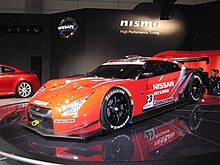
Nismo, the motorsport arm of Nissan, will be entering the Nissan GT-R in the Super GT race series in the GT500 class for the 2008 season, replacing the Nissan 350Z.[103]
Unlike the production car, the GT500 version has a completely different drivetrain. The race car has a 4.5 litre naturally-aspirated V8 with 6 speed sequential manual gearbox and a RWD layout from its predecessor, the 350Z race car.[104]
A prototype was spotted testing around the Suzuka Circuit as well as Fuji Speedway in Japan.[105][106] The car itself went on to win the opening race of the 2008 Super GT season at Suzuka scoring a one-two finish for Nissan.[107] The dominant performances in the opening race has led to all GT-Rs being applied a 50 kg weight penalty in addition to the race weight penalty under the Special Adjustment of Performance under the Super GT regulations.[108] In race two, the GT-R repeated their 1-2 result in Suzuka despite the race winning car of team Nismo carrying a 100 kg weight penalty making it only the 3rd team in JGTC/Super GT history to do so. The last time this feat was achieved was 10 years ago by Nismo Skyline GT-R racing under the same number 23.[109] Despite the weight handicap, it did in fact become the champion in this 2008 season through the Xanavi Nismo GT-R driven by Satoshi Motoyama and Benoit Treluyer, as well as winning 7 out of 9 races driven by 4 different teams using GT-Rs.
FIA GT
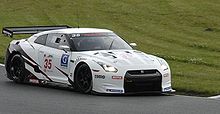

On 27 February 2009, Nismo announced a partnership with British racing team Gigawave Motorsports to enter a GT-R in four races in the 2009 FIA GT Championship season. The entry will not be competing for championship points, but will be used by Nismo to refine the performance of the GT-R for future customer teams to use the car in the planned FIA GT1 World Championship in 2010. Nismo driver Michael Krumm and Gigawave driver Darren Turner will co-drive the GT1 GT-R.[110]

Other categories
A production-based GT-R made its world motorsport debut in Australia's Targa Tasmania tarmac rally in April 2008,[111] however it sustained damage early in the event and did not complete the rally.[112] Later in 2008 a GT-R won the Competition Modern class in the Targa West[113] before returning to Targa Tasmania in 2009 to take the outright win in the Modern class.[114] In 2009 Nissan's GT-R won the One Lap of America competition.[115]
Non-competitive appearances
The GT-R was used as the official safety car for both the 2008 Japanese Super GT, and the 2009 Australian V8 Supercars series[116] before a dispute over alcohol advertising led to the arrangement being discontinued after four rounds.[117]
Aftermarket tuning
Despite early concerns about the difficulty of modification of the Nissan GT-R, a number of modifications have been released. The previously reported "untuneable" ECU has since been hacked by several tuning houses.
MINE'S has decoded its ECU, and others (MCR,[118] HKS, and Top Secret) have bypassed the unit. They have been seen testing modified GT-Rs with the former two having conducted tests at the Tsukuba Circuit.[119][120]
In a review by Motor Trend editor Scott Kanemura, it was revealed that the GPS system fitted to the GT-R would remove the 180-kilometer per hour (112 mph) speed limiter when the car arrives at a race track, but only on tracks approved by Nissan. Aftermarket ECUs have been developed to bypass the speed limiter, in addition to stand-alone speed-limiter defeaters. The GPS check will not be implemented in American models.[121]
In August 2008, Nissan's official motorsport and tuning arm Nismo announced the "Club Sport" tuning package for the GT-R . The package, which is also fitted to the SpecV,[122] includes Bilstein Damptronic compatible dampers, 20" forged aluminum wheels from Rays Engineering, Bridgestone run-flat tires, Recaro carbon fiber-shelled bucket seats, a titanium exhaust, and a revised rear diffuser with an added cooling duct.[123] The package is supported by a warranty and saves over 20 kg.
Awards
- Top Gear Awards 2007 - Supercar of the Year 2007[124]
- Automobile Magazine - 2009 Automobile of the Year[125]
- Evo Magazine - Car of the Year 2008[126]
- Edmunds.com - 2009 Edmunds' Inside Line Editors' Most Wanted Awards: Instant Classic[127]
- Motor Trend - 2009 Motor Trend Car of the Year [128]
- 2008 Japan's Most Advanced Technology Award[129]
- Popular Mechanics - Automotive Excellence Awards 2008 (Design)[130]
- Popular Science - Auto Tech Grand Award Winner[131]
- 2009 International Car of the Year[132]
- World Performance Car 2009[133]
References
- ^ a b Carbonare, Dino Dalle; et al. (2006). Jtuner 11. Future Publications. pp. 8–18.
{{cite book}}: Explicit use of et al. in:|first=(help) - ^ a b Chang, Richard (Summer), "Access Denied", 0-60 Magazine
{{citation}}: Check date values in:|date=and|year=/|date=mismatch (help) - ^ LeftlaneNews R32, R34 Nissan Skyline imports halted
- ^ LASD Inmate Information Center - Booking Details
- ^ a b Akihiko Nakaya et al. (2003). Best Motoring International, 350Z Shock (DVD). Zigzag Asia.
{{cite AV media}}: Explicit use of et al. in:|authors=(help) - ^ "Prince Skyline" (in Japanese). Retrieved 2006-09-22.
- ^ a b c "Nissan Skyline History: 1st and 2nd Generation".
- ^ a b "Nissan Skyline 2000 GT-R KPGC10". JB car pages. Retrieved 2008-10-26.
- ^ "Nissan Skyline History: 3rd - 5th Generation".
- ^ "J's Tipo Magazine". 1997.
{{cite journal}}: Cite journal requires|journal=(help); Unknown parameter|month=ignored (help) - ^ Australian Motor Racing Year, 1986/87, page 273
- ^ Australian Motor Racing Year, 1987/88, page 213
- ^ "R32 Nissan Skyline GTR Review". JB car pages. Retrieved 2008-10-26.
- ^ Butler, Andy (2006). Skyline GT-R The Ultimate Japanese Supercar. Haynes. p. 25. ISBN 1-84425-105-5.
- ^ Donnon, Martin; et al. (2005). High Performance Imports 57. Express Motoring Publications. p. 91.
{{cite book}}: Explicit use of et al. in:|first=(help) - ^ Butler, Andy (2006). Skyline GT-R The Ultimate Japanese Supercar. Haynes. pp. 21–33. ISBN 1-84425-105-5.
- ^ Motoharu Kurosawa (Gan-San) et al. (2005). Best Motoring International, Nismo Beast Unleashed (DVD). Zigzag Asia.
{{cite AV media}}: Explicit use of et al. in:|authors=(help) - ^ Keiichi Tsuchiya et al. (2005). Best Motoring International, RB Japanese Muscle (DVD). Zigzag Asia.
{{cite AV media}}: Explicit use of et al. in:|authors=(help) - ^ Butler, Andy (2006). Skyline GT-R The Ultimate Japanese Supercar. Haynes. p. 36. ISBN 1-84425-105-5.
- ^ Ellis, Ben; et al. (2001). High Performance Imports 15. Express Motoring Publications. pp. 74–78.
{{cite book}}: Explicit use of et al. in:|first=(help) - ^ "R33 Nissan Skyline GTR Review". JB car pages. Retrieved 2008-10-26.
- ^ "Nismo 400R". JB car pages. Retrieved 2008-10-26.
- ^
Nunn, Peter (2006). Wheels. Australia: ACP Magazines. p. 13.
{{cite book}}: Unknown parameter|month=ignored (help) - ^ "R34 Nissan Skyline GTR Review & Specs". JB car pages. Retrieved 2008-10-26.
- ^ スカイライン CM情報
- ^ 【プレゼント企画】「SKYLINE 50th ANNIVERSARY CD」×2
- ^ JNC In Japan: Day 4
- ^ Skyline turning 50, Nissan to celebrate in Tokyo
- ^ a b "V35 Nissan Skyline". JB car pages. Retrieved 2008-10-26.
- ^ Ellis, Ben; et al. (2005). High Performance Imports 54. Express Motoring Publications. pp. 42–48.
{{cite book}}: Explicit use of et al. in:|first=(help) - ^ Warne, Grant; et al. (2005). High Performance Imports 62. Express Motoring Publications. pp. 44–48.
{{cite book}}: Explicit use of et al. in:|first=(help) - ^ "Nissan Introduces All-New Skyline". Nissan Press Release. 20 November 2006. Retrieved 2006-11-26.
Nissan Motors
{{cite web}}: Text "Nissan, today introduced the 12th generation Skyline, featuring all-new exterior and interior designs, the next generation FR-L platform and newly developed VQ35HR V6 engine." ignored (help) - ^ スカイライン セダンの期間限定車「50th Limited」を発売
- ^ "新型スカイライン 「50th Limited」誕生".
- ^ EX Phone Home: Nissan rebadges Infiniti EX as Skyline Crossover for JDM
- ^ All data according to: http://www2.nissan.co.jp/GT-R/R35/0710/index.html
- ^ "2009 Nissan GT-R Specs and Standard Features". Retrieved 2007-10-24.
- ^ "Car and Driver - First Look Nissan GT-R".
- ^ "2009 Nissan Skyline GT-R". Inside Line.
- ^ "First Look: 2008 Nissan GT-R". MotorTrend.
- ^ "Nissan Skyline GT-R". evo.co.uk. p. 1. Retrieved 2008-10-09.
- ^ "Nissan Skyline GT-R". Zimbio. p. 1. Retrieved 2008-10-09.
- ^ "Under the hood of the Nissan GT-R". Autoblog. 2007-09-11. Retrieved 2007-09-11.
- ^ "Nissan GT-R Press Information - Specifications". Nissan. Retrieved 2007-11-01.
- ^ Ryan, Colin. "2008 Nissan GT-R". compactcarweb. p. 2. Retrieved 2008-08-26.
- ^ Blackburn, Richard (February 29, 2008). "Nissan GT-R: 'Godzilla' returns..." drive.com.au. p. 1. Retrieved 2008-08-26.
- ^ "2001 Nissan GT-R Concept". JB car pages. Retrieved 2008-06-22.
- ^ "TOKYO NEWS: Nissan Reveals Juicy Tidbits About 2007 GT-R Supercar". edmunds.com. 2005-10-18. p. 1. Retrieved 2008-08-26.
- ^ 2009 "Nissan GT-R - AutoWeek". 2007-10-17. Retrieved 2007-10-24.
{{cite web}}: Check|url=value (help); Check date values in:|date=(help) - ^ "Nissan Press Release - Nissan Announces New Nissan GT-R". 2007-10-24. Retrieved 2007-10-24.
- ^ "Nissan GT-R Specification". Nissan. Retrieved 2008-09-25.
- ^ "2009 Nissan GT-R: True Power From the Dyno". Edmunds.
- ^ "2009 Nissan GT-R - Dyno Test - Results and Analysis". Motor Trend.
- ^ "Nissan GT-R Features". JB car pages. Retrieved 2008-06-22.
- ^ "2009 Nissan GT-R Specs and Standard Features".
- ^ "Fast Times: Nissan GT-R Sets New Nurburgring Record". Edmunds.
- ^ Nissan raises GT-R MSRP by nearly $7,000
- ^ "Breaking News: Undisguised 2009 Nissan GT-R". edmunds.com. Retrieved 2008-01-16.
- ^ Comparison: ZR1 vs GT-R vs GT2 vs 599 Top Speed Run Video
- ^ "Motor trend Nissan R35 GT-R (USDM) Exclusive Track Test".
- ^ So, Just How Slow is a Nissan GT-R Without Launch Control Engaged?
- ^ "Road & Track Magazine - Driving Impression: 2010 Nissan GT-R (3/2009)". Roadandtrack.com. Retrieved 2009-07-07.
- ^ a b GT Channel. http://www.youtube.com/watch?v=w1bHGaV-Lvw 2010 GT-R Launch Control Controversy Explained on video
- ^ "Jay Leno's Garage: GT-R Review". youtube.com. Retrieved 2008-08-11.
- ^ Autoblog. Nissan drops Launch Control from 2010 GT-R
- ^ Nissan drops Launch Control from 2010 GT-R
- ^ Automotiveaddicts.comNissan GT-R Launch Control Reprogram Clarification from Nissan
- ^ "2009 Nissan GT-R acceleration runs". Motortrend.com. 2007-02-26. Retrieved 2009-12-19.
- ^ "YouTube - Nissan GT-R | Porsche 911 GT3 | BMW M3 [Autocar] - Part 2". Youtube.com. Retrieved 2008-10-27.
- ^ "AWARD-WINNING NISSAN GT-R ACHIEVES NEW RECORD LAP TIME AT NURBURGRING CIRCUIT". Nissan.
- ^ "Fast Times: Nissan GT-R Set New Nürburgring Record". Edmunds.
- ^ GT-R Achieves Under 7:30 at Nurburgring
- ^ Gover, Paul (2008-09-30). "Porsche accuses Nissan of cheating at Nurburgring". Carsguide.com.au. News Limited. Retrieved 2008-09-30.
- ^ "Autocar - Porsche says Nissan cheating". Autocar.co.uk. Retrieved 2008-10-27.
- ^ Korzeniewski, Jeremy (2008-10-03). "Nissan defends GT-R 'Ring time". Autoblog. Retrieved 2008-10-03.
- ^ Roth, Dan (2008-10-09). "Nissan defends GT-R 'Ring time". Autoblog. Retrieved 2008-10-03.
- ^ a b "Nissan GT-R: Ost-Erweiterung". sportauto (in German). Retrieved 2008-10-02. Cite error: The named reference "SAringtime" was defined multiple times with different content (see the help page).
- ^ Harris, Chris (2008-11-24). "The Truth". Driver's Republic. p. 23. Retrieved 2008-11-27.
- ^ "Corvette ZR1 im Supertest auf der Nordschleife: Was kann die stärkste Corvette aller Zeiten? | Tests | Sportauto". Sportauto-online.de. Retrieved 2009-12-19.
- ^ "Nissan GT-R - Road Test First Drive". Autocar.co.uk. Retrieved 2009-07-07.
- ^ "Autocar Videos". Autocar.co.uk. Retrieved 2009-07-07.
- ^ "Autocar Videos". Autocar.co.uk. Retrieved 2009-07-07.
- ^ "Autocar Videos". Autocar.co.uk. Retrieved 2009-12-19.
- ^ "Nissan GT-R v Porsche 911 Turbo video part 2 | Car Video & Clips | Car Magazine Online". Carmagazine.co.uk. 2008-02-19. Retrieved 2009-12-19.
- ^ Text: Richard Meaden / Photos: Andy Morgan (2008-04-02). "Nissan GT-R and Porsche GT3 | Car Review Group Test". evo. Retrieved 2009-07-07.
- ^ About the Author — turbox (View Profile). "Porsche 911 Turbo V Nissan GT-R - Fifth Gear By Senna - AutoSpies Auto News". Autospies.com. Retrieved 2009-12-19.
{{cite web}}:|author=has generic name (help)CS1 maint: multiple names: authors list (link) CS1 maint: numeric names: authors list (link) - ^ "2008 BMW M3 vs. 2009 Nissan GT-R vs. 2008 Porsche 911 Turbo - Coupes/Comparison Test/Reviews/Car and Driver". Car And Driver. 2008-03-23. Retrieved 2009-07-07.
- ^ Sam Mitani (2008-05-01). "Comparison Test: Nissan GT-R vs. Chevrolet Corvette Z06 vs. Porsche 911 Turbo". Hachette Filipacchi Media, U.S., Inc. Retrieved 2008-10-13.
- ^ [1][dead link]
- ^ "2009 Nissan GT-R vs. the World Ultimate Performance Car Test". Edmunds.com. 2008-05-26. Retrieved 2009-07-07.
- ^ "Vergleich Nissan GT-R/Porsche 911 Turbo/Audi R8 V10 - Die Runde der Wahrheit". autobild.de. Retrieved 2009-12-19.
- ^ "Autocar Videos". Autocar.co.uk. Retrieved 2009-12-19.
- ^ "Auto, Motor Und Sport - Vergleichstest der 500 PS-Supersportler". /www.auto-motor-und-sport.de. Retrieved 2010-01-05.
- ^ http://www.sportauto-online.de/rundenzeiten-supertests-1062778.html
- ^ "CAR Magazine, July 2009". www.carmagazine.co.uk. Retrieved 2010-01-05.
- ^ Hellwig, Ed (2008-10-27). "Comparison Test: 2009 Chevrolet Corvette ZR1 vs. 2009 Nissan GT-R". Inside Line. Edmunds Inc. Retrieved 2008-10-28.
- ^ St. Antoine, Arthur (2008-10-27). "War of the Worlds: ZR1 vs GT2 vs 599 vs GT-R". Motor Trend. Source Interlink Media. Retrieved 2008-10-28.
- ^ "BBC - Top Gear - Power Laps". 2008-10-02. Retrieved 2008-10-18.
- ^ Matt Vella (November 26, 2007). "Nissan Redesigns a Japanese Icon". Businessweek.com. Retrieved 2008-10-27.
- ^ "Edmunds Inside Line: A Day in Germany With the GT-R Engineers".
- ^ Nissan GT-R SpecV unveiled!
- ^ Nissan GT-R SpecV: Super-Godzilla Caught On Tape
- ^ "「NISSAN GT-R」が SUPER GT に参戦" (in Japanese). Nissan Motorsports.
- ^ Autocar - Meet the V8 Nissan GT-R
- ^ "NAGTROC gallery - Super GT GT-R".
- ^ http://www.gtr-world.net/photogallery/racecars/gtr-production-race-car.html (Japanese) Google translation
- ^ "Super GT 2008 Round 1 Suzuka Race Review".
- ^ "Super GT 2008 Fuji Official Test".
- ^ "Super GT 2008 Round 2 Okayama Race Review".
- ^ "2009 Nismo - Gigawave Motorsport announcement". FIA GT Championship. 2009-02-27. Retrieved 2009-02-27.
- ^ "Nissan GT-R confirms Targa Appearance 2008".
- ^ "2008 Targa Tasmania Modern Competition results" (PDF).
- ^ "2008 Targa West Modern Competition results" (PDF).
- ^ "Targa Wrest Point all go and filling fast". 15 May 2009.
- ^ "the Official Webpage". One Lap of America. Retrieved 2009-07-07.
- ^ "GT-R confirmed as new Safety Car".
- ^ "V8 Supercars: V8SA And Nissan Scrap Corporate Partnership".
- ^ "セントラル:New 日産 GT-R" (in Japanese).
- ^ "Option Fans Magazine". No. 78. Unity Media Communications. 2008. p. 12, 56.
{{cite news}}: Unknown parameter|month=ignored (help) - ^ "Option Fans Magazine". No. 78. 2008. p. 12, 56.
{{cite news}}: Unknown parameter|month=ignored (help) - ^ "Nissan GT-R can't take aftermarket wheels, unapproved race tracks are out". Auto Blog.
- ^ "NISMO NEWS RELEASE" (in Japanese).
- ^ "NISMO NEWS RELEASE" (in Japanese).
- ^ Jason Barlow. "TopGear Galleries - TG Awards '07". Retrieved 2008-01-17.
- ^ 2009 Automobile of the Year: 2009 Nissan GT-R.automobilemag.com.
- ^ "Nissan GT-R | Car News". evo. 2008-12-08. Retrieved 2009-07-07.
- ^ "2009 Edmunds' Inside Line Editors' Most Wanted Awards". Edmunds.com. Retrieved 2009-07-07.
- ^ "2009 Nissan GT-R - The 2009 Motor Trend Car of the Year Winner is the Nissan GT-R". Motor Trend. Retrieved 2009-07-07.
- ^ "日本カー・オブ・ザ・イヤー:受賞車・特別賞受賞車". Jcoty.org. Retrieved 2009-07-07.
- ^ By PM's Automotive Editors (2007-11-06). "Nissan GT-R: Automotive Excellence Design Award Winner". Popular Mechanics. Retrieved 2009-07-07.
{{cite web}}:|author=has generic name (help) - ^ "2009 Nissan GT-R | Popular Science". Popsci.com. Retrieved 2009-12-19.
- ^ "2009 International Car of the Year Awards' Winners : ROAD & TRAVEL Magazine". Roadandtravel.com. Retrieved 2009-07-07.
- ^ "World Car of the Year Awards". wcoty.com. 2009-04-09. Retrieved 2009-07-07.
Further reading
- Gorodji, Alex (2008). Nissan GT-R: Legendary performance, Engineering Marvel. Minnespolis: Motorbooks. ISBN-978-0-7603-3036-4.
{{cite book}}: Unknown parameter|Pages=ignored (|pages=suggested) (help)
External links
- Nissan GT-R official global site
- Nissan GT-R press information
- Nissan GT-R information and videos
- AUSmotive.com - GT-R image gallery
- AUSmotive.com - GT-R Spec V image gallery
- North American GT-R Owners Club
- GTROC
Notes
External links
- Nissan vehicles
- Nissan concept vehicles
- All wheel drive vehicles
- Coupes
- Sports cars
- 2000s automobiles
- Vehicles introduced in 2007
- Vehicles with CVT transmission
- 1950s automobiles
- 1960s automobiles
- 1970s automobiles
- 1980s automobiles
- 1990s automobiles
- Vehicles introduced in 1957
- Vehicles with four wheel steering
- Australian cars

